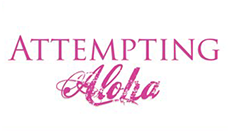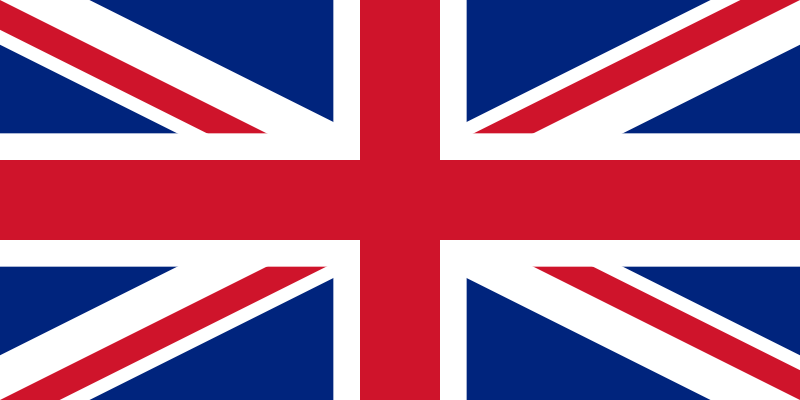 Welcome to the home and premier site of the authentic British Teddy Boy.
Welcome to the home and premier site of the authentic British Teddy Boy.
_______________________________________________________________________
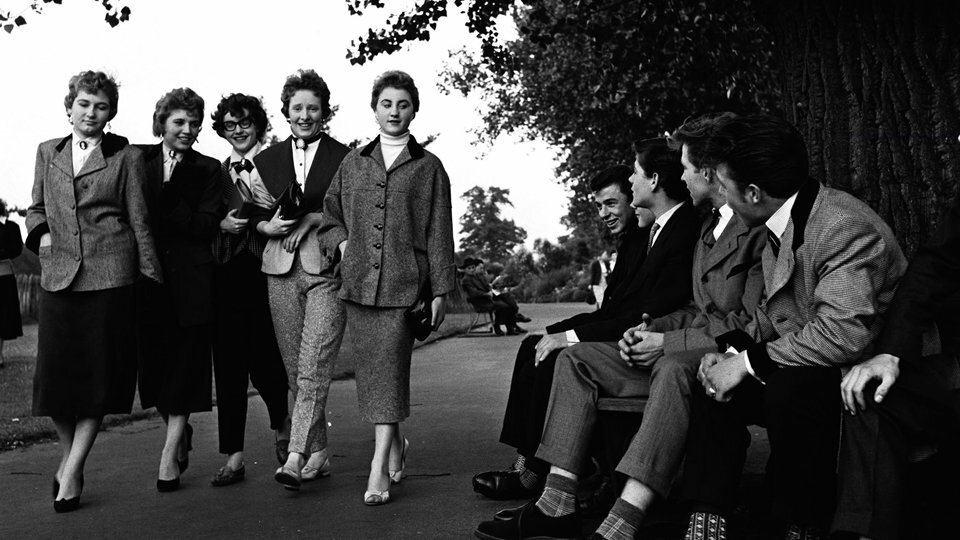
Teddy Boys admiring the view on Clapham Common in 1954. This was a year after the infamous Teddy Boy Murder in which John Ernest Beckley (17) Apprentice Electrical Engineer, from Walworth, South London died of his stab wounds after he was attacked along with his friends on Clapham Common by a local Teddy Boy Gang known as the Plough Boys.
______________________________________________________________________
In 1953, the major newspapers reported on the sweeping trend in men's fashion across all the towns of Britain, towards what was termed the New Edwardian look.
______________________________________________________________________
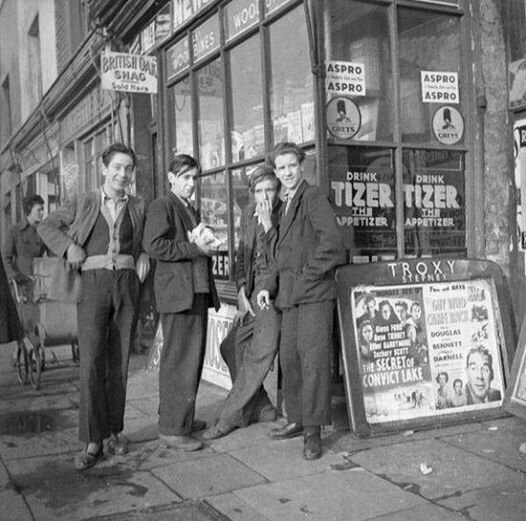
These four working class young lads pictured at Stepney, East London in 1951, dressed in the drab suits of the immediate post war era, were along with thousands of British teenagers waiting for something to happen that would give them a sense of identity and purpose.
At this point in time, there was no such thing as a Teenager, however the Teddy Boy had started to evolve during 1951 as working class teenagers had started to adopt their own variations of the New Edwardian look that had originally been introduced by a group of Saville Row Tailors who were attempting to initiate a new style. The New Edwardian Look was addressed, primarily, to the young aristocratic men about town.
When the long jackets and tight trousers covered the middle class, the fashion was proclaimed a pleasing innovation. However as South London teenagers took trips over the River Thames into the West End they noticed the New Edwardian style, and decided to adopt it and with some modifications, make it their own. The prime difference between the New Edwardian look worn by the middle classes and that worn by the working class teenagers was the introduction of American Western accessories, such as Maverick ties and Silk Patterned Waistcoats. This is what the fundamental difference would become, that of working class teenagers wearing elements of Western apparel compared to the New Edwardian look which was totally British.
The new Edwardian style was rapidly re-appraised when it spread to these young working-class males in 1951/2. It seems that these new 'Edwardians' had become labelled as 'Spivs', 'Juvenile Delinquents', 'Cosh Boys' and 'Zoot Suiters' not the 'respectable' working class .... as a result, the middle class felt that they could no longer share the style with its new adherents.
_______________________________________________________________________
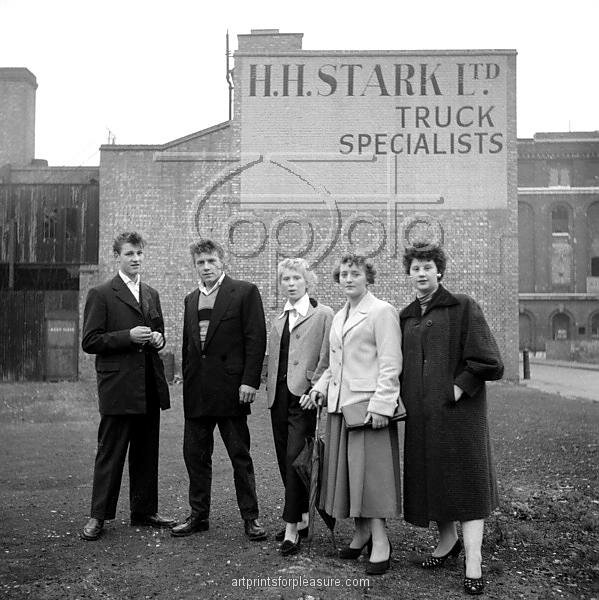
Photo by Ken Russell, January 1955 from the collection "The Last of the Teddy Boys" taken in the East End of London.
_______________________________________________________________________
The 'Working Class Edwardian Style' had been on the street since at least 1951, because the style had been created on the street by the street and by working class teenagers, not by Saville Row or the fashion designers.
______________________________________________________________________
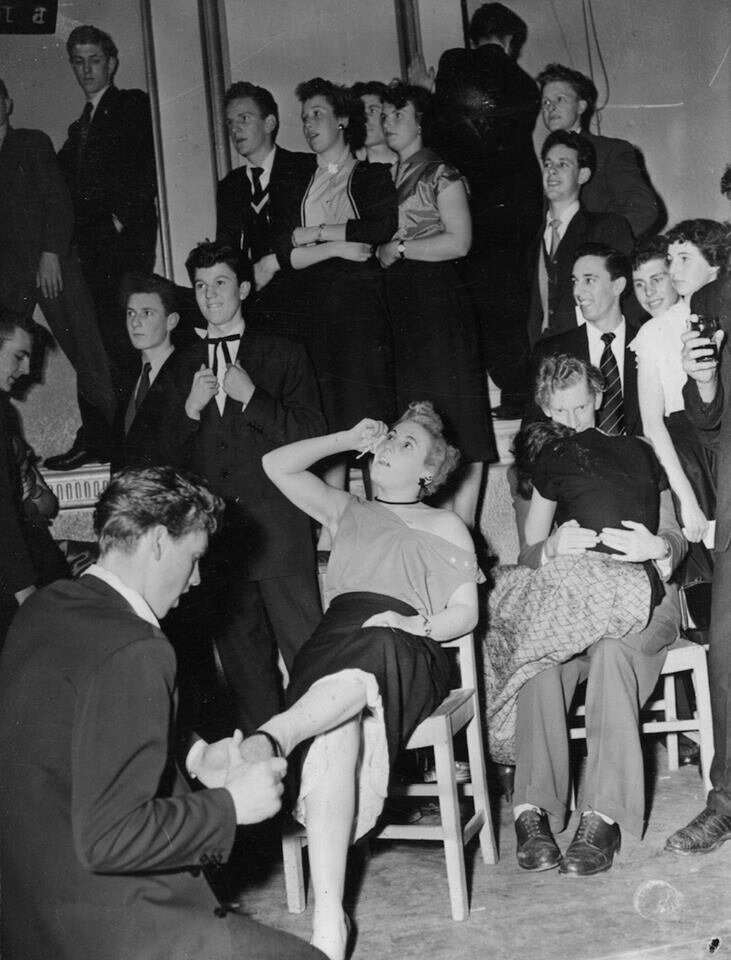
Teddy Boys and Teenagers before the advent of Rock 'n'Roll in England - 18th February 1954:
Jazz fans collapsed onto chairs, overcome with emotion, at a crowded dance hall where their idols of song - Ted Heath, Dickie Valentine and Lita Roza are performing.
______________________________________________________________________
The 'Edwardian's' or a least 'The Working Class Edwardian' emerged without much warning .......
There was little preparation for his appearance as a fully fledged deviant, ( a person defined as a social problem) ....
He had curious parents; one was the upper-class Edwardian dandy, the other the older delinquent subculture of South London ....
his clothes were originally worn by the middle and upper classes, but this was only for a short period.
______________________________________________________________________
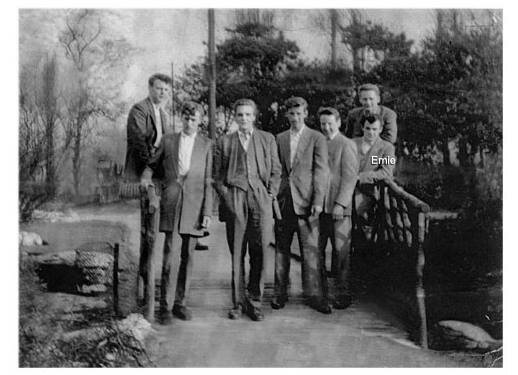
A group of early 1950's Salford Teddy Boys pose in a Park.
_______________________________________________________________________
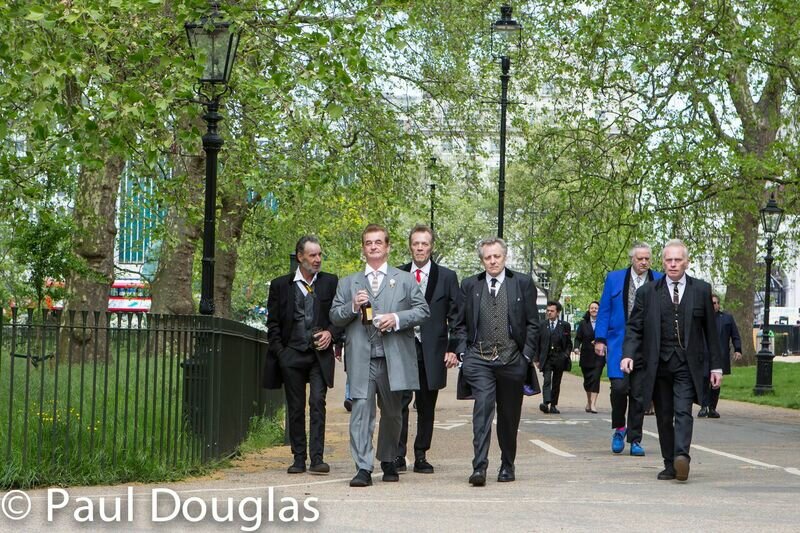
A group of Teddy Boys that were around in the 1970's prepare to take part in the 40th Anniversary of the 1976 March to the BBC on Saturday 14th May 2016 in Hyde Park, Central London.
Copyright and Photograph Courtesy of Paul Douglas, Colchester, Essex.
_________________________________________________________________________
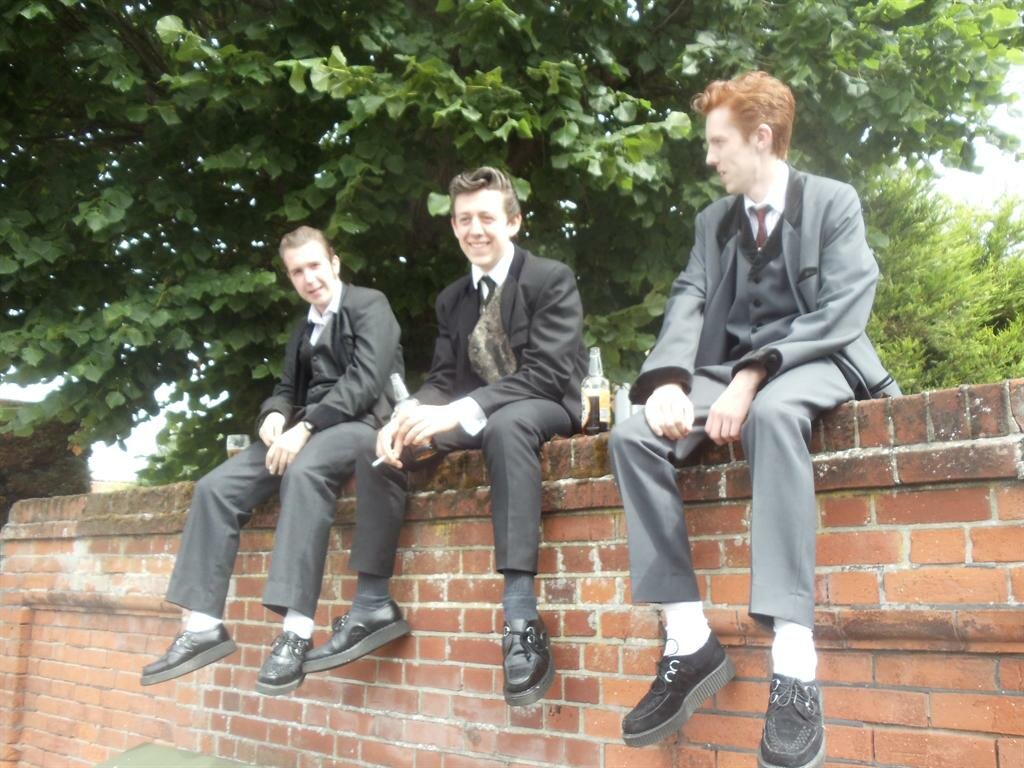
A new generation Teddy Boys keeping the movement alive - Daire Kimmage, Connor Brennan and Lee Cummins from Dublin at the Tramway Hotel, Pakefield, Lowestoft, England on 5th July 2014.
______________________________________________________________________
"What's a Teddy Boy?"
"A London hoodlum!" Well what the hell did I know about "Teddy Boys?". I found out later that they were British working-class teenagers who represented the vanguard of that nation's emerging youth culture.
-American Rock n Roller Charlie Gracie in discussion with the Stage Manager at the Southampton Gaumont, August 1957
______________________________________________________________________
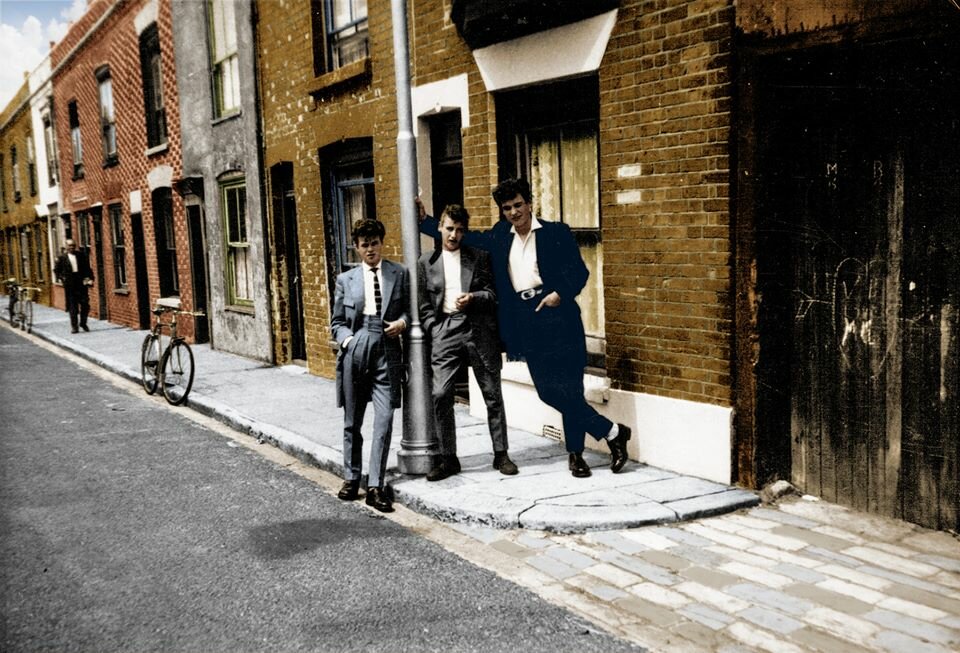
1957 Somers Street, Portsmouth. The boys, from left to right in the main picture, were Hugh Finnegan, then an apprentice plumber and Micky Hoskins, who was called up shortly after the picture was taken, he went into the Grenadier Guards. On the right is Eddie Rowlands who was also called up and joined the army. After a few months he broke a leg and returned home for three months before re-joining his unit.
Hugh managed to escape conscription because he was an apprentice plumber. Hugh says the suit he is wearing in this picture cost him 14 guineas (£14.70) and was bought from Dennis Lee in New Road, Portsmouth. Copyright and Courtesy of Hugh Finnegan.
______________________________________________________________________
The first mention of Teddy Girls in the press, and almost exactly a year before the Picture Post article, was in the Daily Express in June 1954.
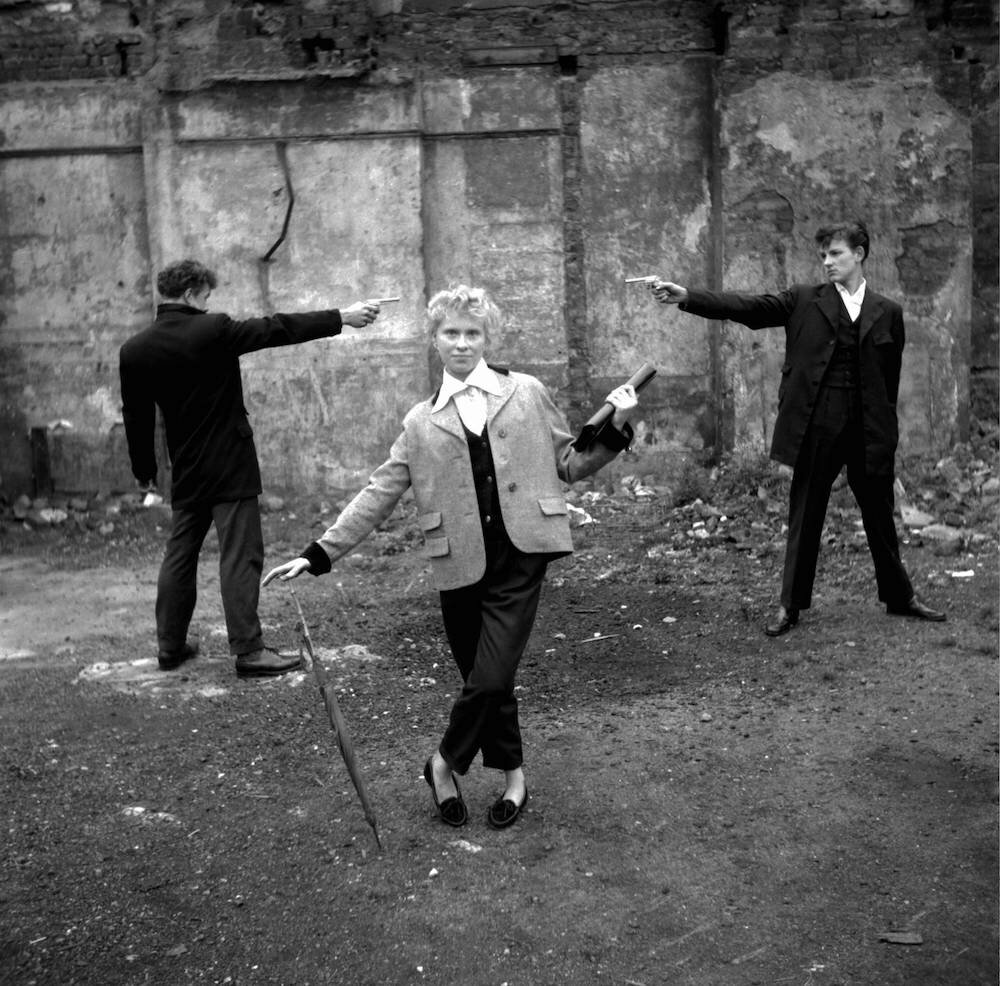
16 year old Eileen from Bethnal Green, with two teddy boys "duelling" over her on an East End bombsite.
"Teddy Clothes", began a Picture Post article in June 1955, and illustrated by the 27 year old photographer Ken Russell, "can cover a multitude of sins - or juvenile delinquencies…"
______________________________________________________________________
"She was auburn-haired and fifteen. She wore tight-fitting trousers, a sweater, and brightly coloured socks. And she carried a small dagger."
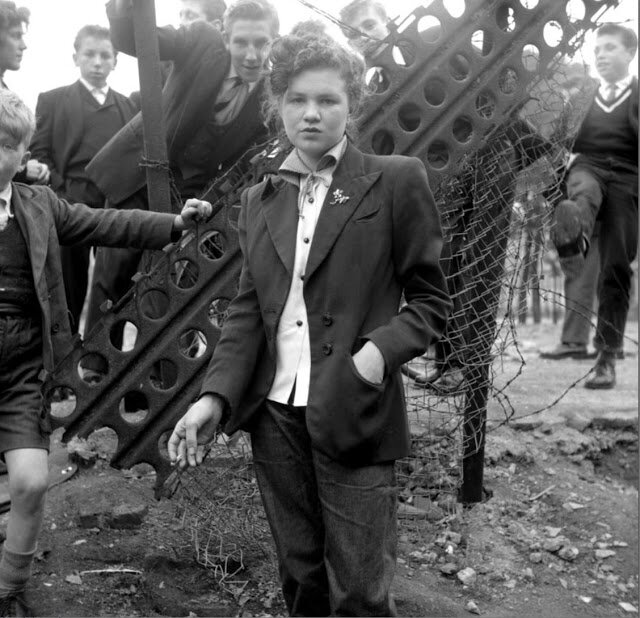
Jean Rayner - "A fourteen year old, with her jeans and old jacket, still in the probationary stage of Teddyism. Later, she may smarten up to senior standards." Picture Post, June 1955. "She had attitude by the truckload", remembered Ken Russell. "No one paid much attention to the teddy girls before I did them, though there was plenty on teddy boys. They were tough, these kids, they'd been born in the war years and food rationing only ended in about 1954 - a year before I took these pictures. They were proud. They knew their worth. They just wore what they wore."
______________________________________________________________________
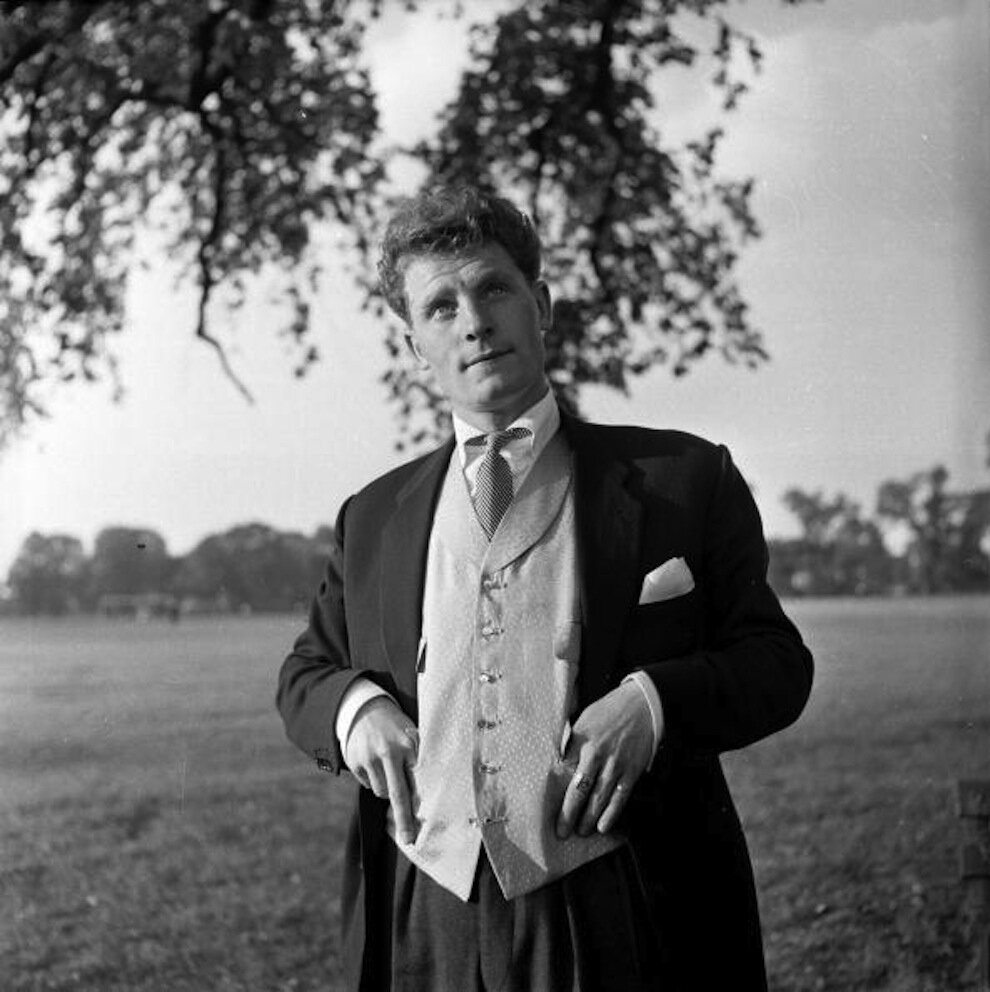
10th October 1953 London gang member Colin Donellan dressed in fashionable Edwardian Teddy Boy style on Clapham Common. One of the historic icons of the original Teddy Boy Movement.
The name "Teddy Boy", was not officially born until September 23rd 1953 when a Daily Express newspaper headline shortened Edward to Teddy and coined the term 'Teddy Boy'. Nevertheless, it is also known that a number of girlfriends of working class Edwardian's were referring to them as Teddy Boys well before the Daily Express used its media power to officially christen Edwardian's into Teddy Boys.
___________________________________________________________________
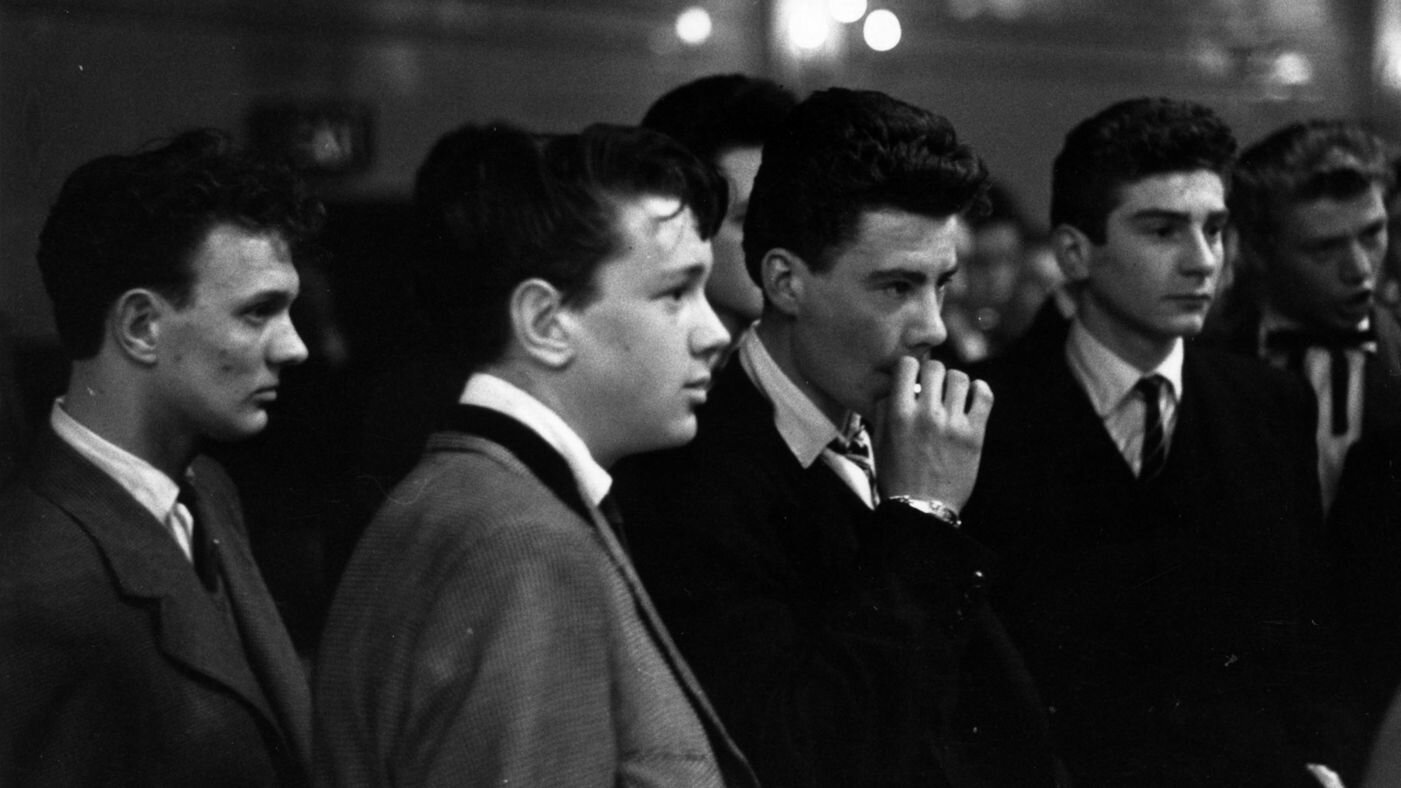
Teddy Boys at the Mecca Royal Dance Hall, Tottenham, Middlesex (North London) pictured in the Picture Post on 29th May 1954 in the article, The Truth about Teddy Boys.
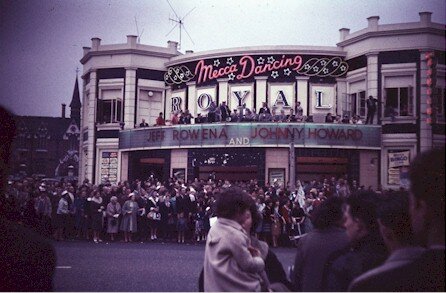
Originally an Ice skating Rink and a year after a Cinema, in 1925 the building that was to become the Tottenham Royal was converted into a dance hall known as the Tottenham Palais and became a popular jazz venue. Later it was bought by the Mecca Leisure Group and became the Tottenham Royal, North London's premier nightspot for big band and swing music, with the Johnny Howard Band as resident for a period. The 1950s saw the Royal embrace the Rock n Roll era and above this picture is a well-known photograph from Picture Post of a group of Teddy Boys in the dance hall. The Royal was so popular in the North London area during the 1950's it was known as "The Teddy Boys Graveyard" . This picture was taken outside the venue in 1961.
THEY SAY:
"Our dress is our answer to a dull world"
Teddy Boy at the Mecca Royal Dance Hall, Tottenham, 1954
_______________________________________________________________________

Alec Cruickshank, a clerk in a City of London shipping office poses ready to go into Mecca's Royal Dance Hall, Tottenham, on 29th May 1954. Taken from the Picture Post article: "The Truth about Teddy Boys". Note the 3 button front "Dog Tooth" Drape Jacket and Maverick Tie.
In 1956, the film, Blackboard Jungle made its premier at the Trocadero Cinema at Elephant & Castle in South London. It was then shown thereafter at Cinemas throughout Britain. At the end of the film, the song 'Rock around the Clock' was played and at the Trocodero, Teddy Boys danced with their girls in the aisles and when cinema staff attempted to stop them, they rioted and ripped up the cinema seats with flick knives.
_______________________________________________________________________
The Tony Curtis & Ducks Arse Hairstyle.
_______________________________________________________________________
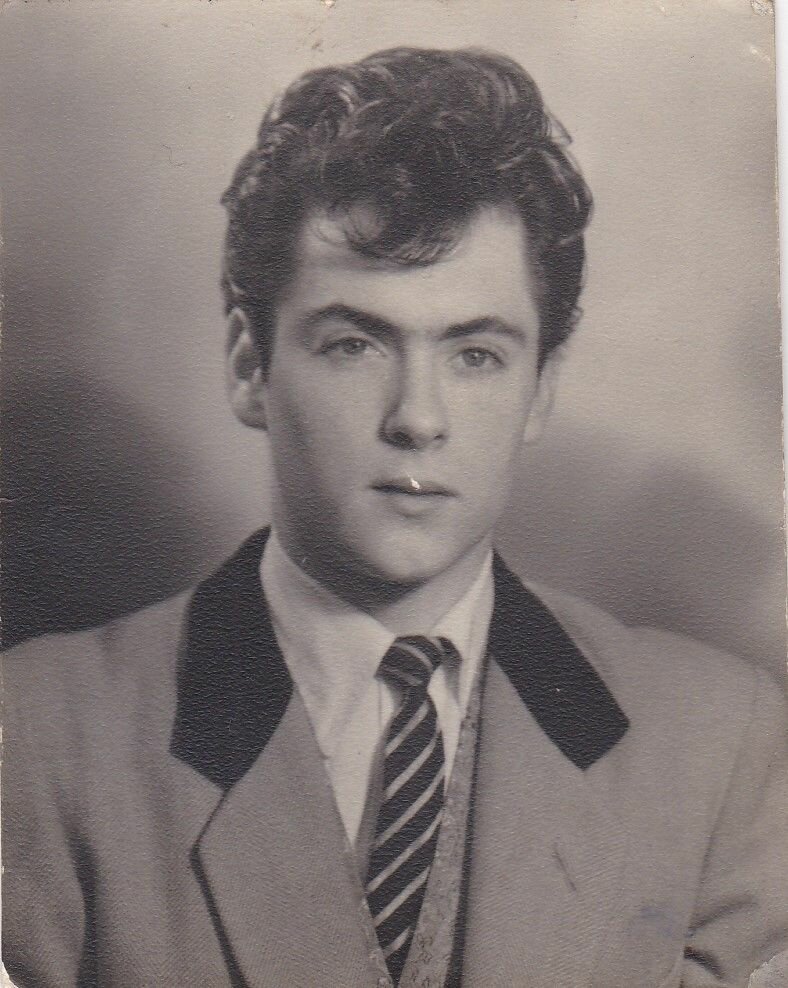
An excellent portrait photograph of mid 1950's Teddy Boy, R.B. Gregory who is sporting a Tony Curtis hairstyle, in fact he could well be Tony Curtis himself, the resemblance is astounding!. The American hairstyle became a popular hairstyle for Teddy Boys and non Teddy Boys as well, as it combined a quiff with a Ducks Arse at the rear, there were many variants of this style. See the 1955 Pathe News clip below.
_______________________________________________________________________
_______________________________________________________________________
"I had my first ted suit in 1955. I was 16, worked in a hot forge and loved the style, music etc. I had my suit tailored by a salesman who used to sell at the door, I ordered it unbeknown to my Mum & Dad, otherwise it would not have been possible (Teddy Boys were taboo to my parents). The suit cost about 5 weeks wages, which was about 30 quid but well worth it, it was midnight blue in colour with a fine black speck in it, wish I still had it. Don't know what happened to it as I did national service in 1958. I think my parents must have got rid of it because I had to sneak out in it when my mates called for me, all of them have since passed on. I remember that I had to pay for the suit on the sly at five bob a week, it seemed never ending". - Joe, Wolverhampton, 7th May 2012."
______________________________________________________________________
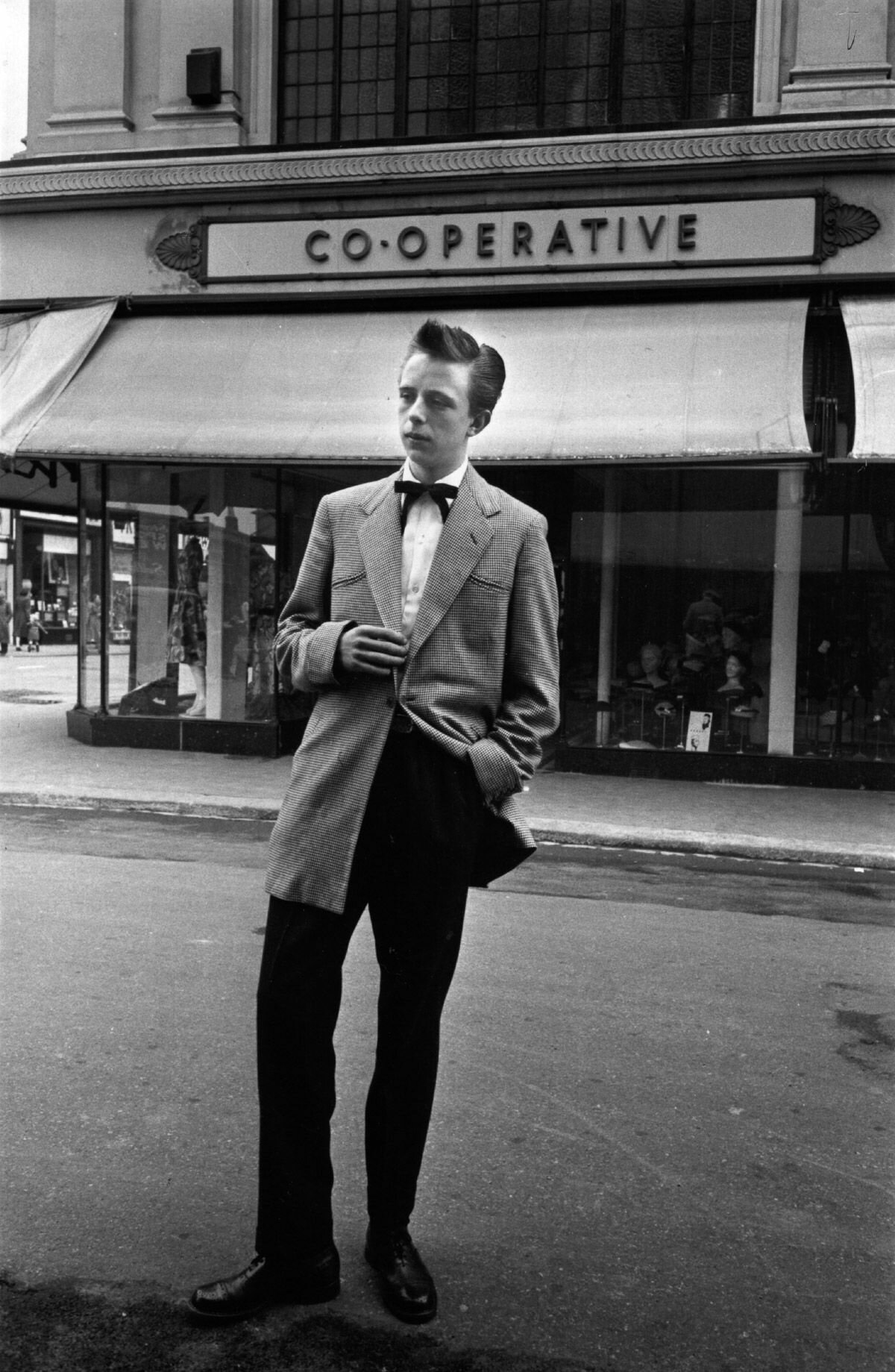
Picture Post, 29th May 1954 - The Truth about Teddy Boys -Teddy Boy, Frank Harvey pictured outside the Co-op in Tottenham, North London. Note the "Dog Tooth" single link Drape Jacket and Black Brogue Shoes. Frank in later years ran a pet shop called "Alan's Pet Supplies" at 75 Silver Street in nearby Edmonton. Apparently when Frank ran the shop he had this photograph of him behind the counter.
When teenager John Beckley was murdered by a Teddy Boy gang known as the Plough Boys in July 1953 after a fight that started on Clapham Common, the Daily Mirror's headline 'Flick Knives, Dance Music and Edwardian Suits' linked criminality to clothes.
_________________________________
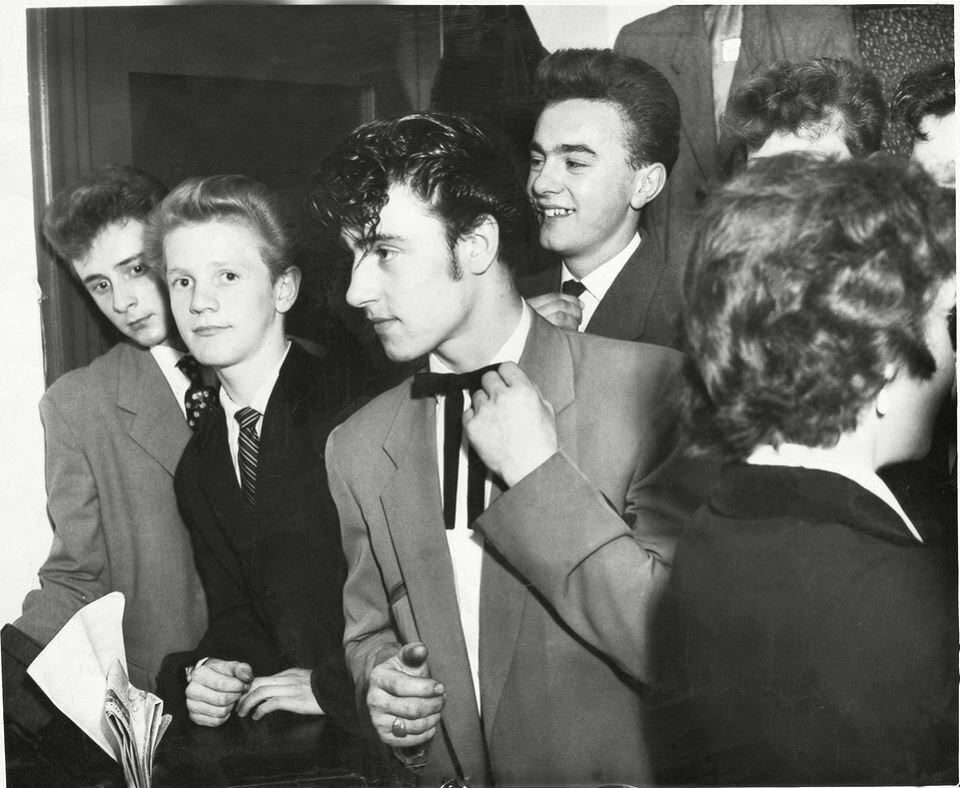
A Best Dressed Teddy Boy Competition at Nottingham in 1956.
"These 'Teddy Boy' gangs must be broken up"
said one London Magistrate.
______________________________________________________________________
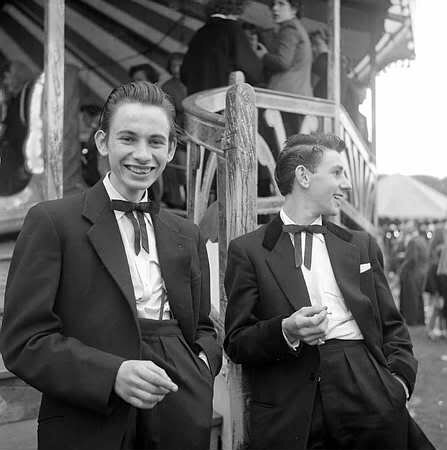
100 TEDDY BOYS FIGHT AT FAIRGROUND
The biggest Teddy Boy gang fight ever known in Leicester flared up at Saffron Lane Fairground in the second week in May of 1958. At the height of the battle, fairground workers joined in to protect their stalls and rides as many Police arrived on the scene. According to the showpeople, there were more than 100 Teds mixed up in the fight, and estimates the number of Police involved ranged from a dozen to nearly 30 or 40. A veteran showman, Mr M. Harris, said this was the worst fight he had seen since the Irish Gang Battle at Coventry some years ago. (The Leicester Mercury headline for May 11th 1958, read '100 Teddy Boys fight at Fairground')
_______________________________________________________________________
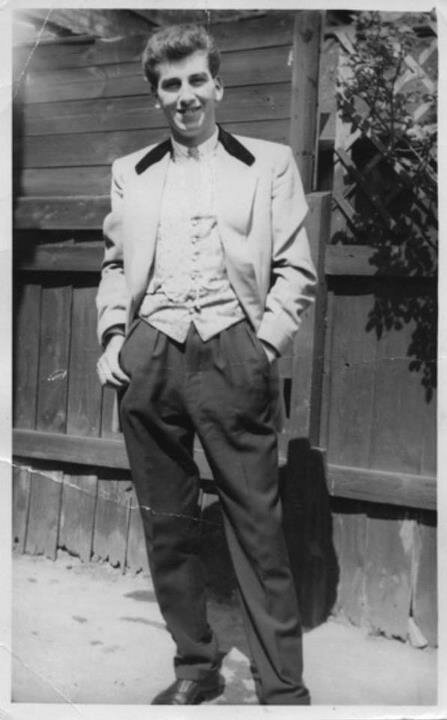
Mick Farrell, a well dressed Teddy Boy from 1956.
"The Teddy Boy myth was born.''
_______________________________________________________________________
An original surviving 1954 Drape Suit found in a Loft in South Wales.
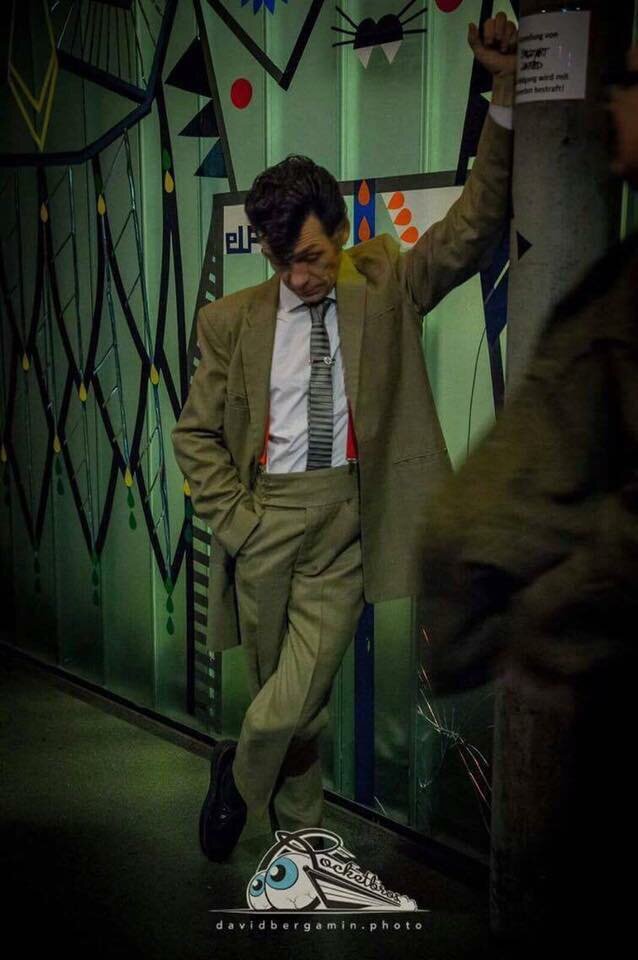
Teddy Boy, Rob Rees pictured in 2017 sporting an original 1954 two piece biege Drape Suit that was wrapped away in Rob's Grandfather's loft in his house in the Valleys of South Wales. Rob says "That's the suit we found in my Grandad's loft in brown paper, it was my Uncles suit back in the Fifties, however it got confiscated by his Dad and ended up in his loft to stop his son from finding it. My Uncle told me the suit was tailored in 1954." His Uncle then gave Rob the suit, who knew that he would wear it with pride and Rob says that the Jacket fits like a glove, however the trousers did need alteration and it can be a bit of a military movement having a piss.The jacket has wide lapels and four jetted pockets with plain cuffs. Rob says "I'm just a lucky bastard, I'm the same size now as my Uncle was in 1954". This proves that, its all about the cut of the suit that makes it what it is, not nescessarily the adornment such as the velvet trim as this clearly has none and it doesn't need it!
_______________________________________________________________________
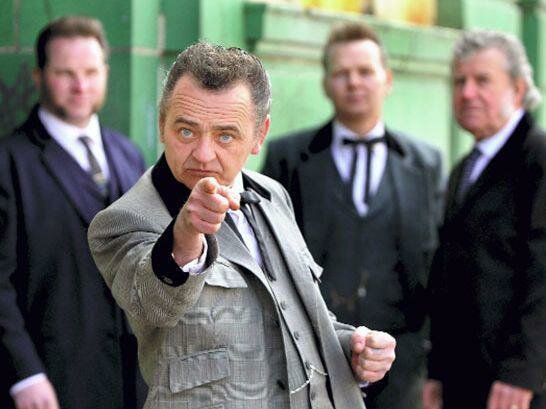
Edwardian Teddy Boy Steven Lyons featured in the Manchester Evening News. See the Teddy Boys are back in Town page.
_______________________________________________________________________
"The Great British Teddy Boy is a rebel of conformity and therefore wears a Style and not a Uniform".
_______________________________________________________________________
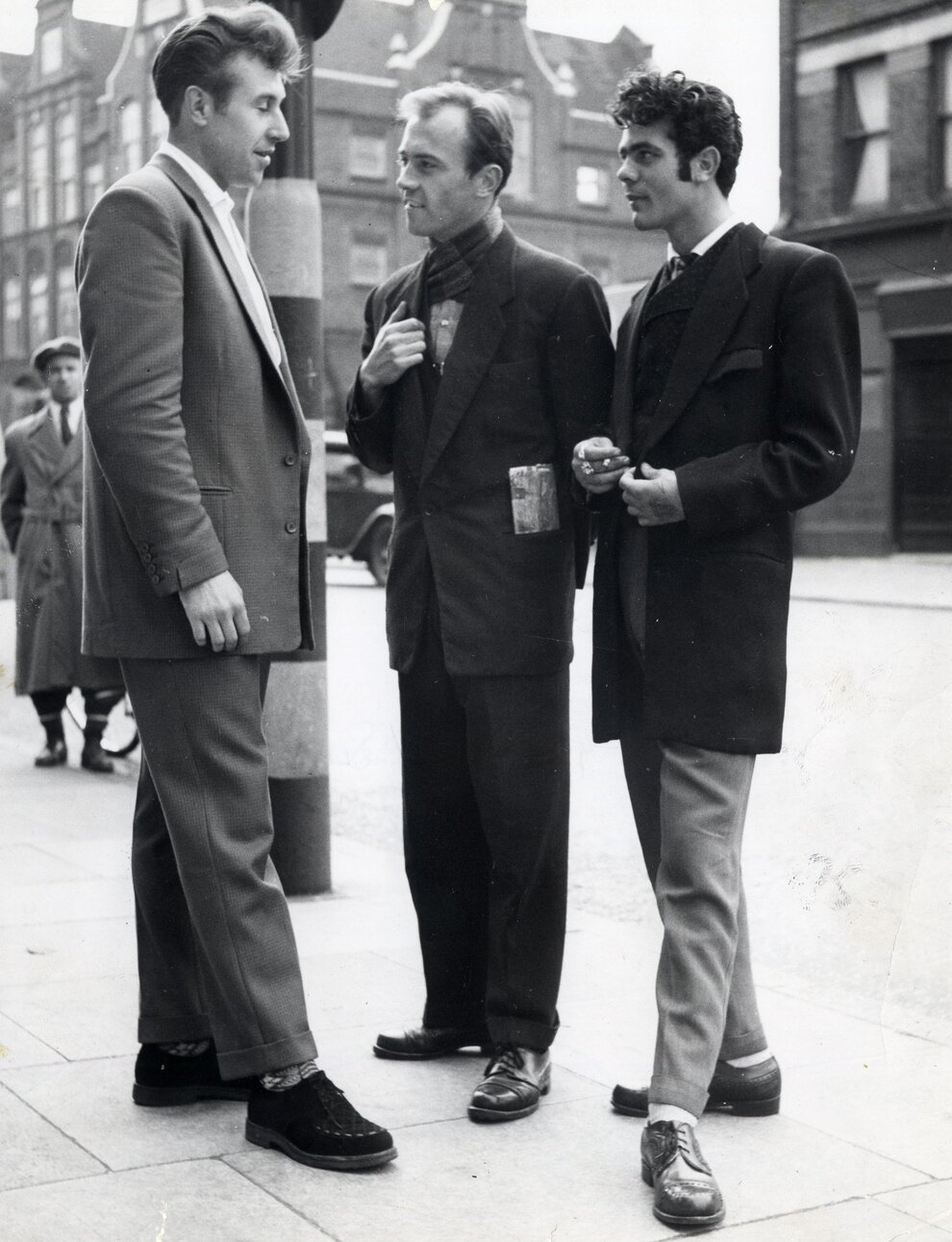
Teddy Boys at Greenwich, London 1956 after a Court case.
______________________________________________________________________
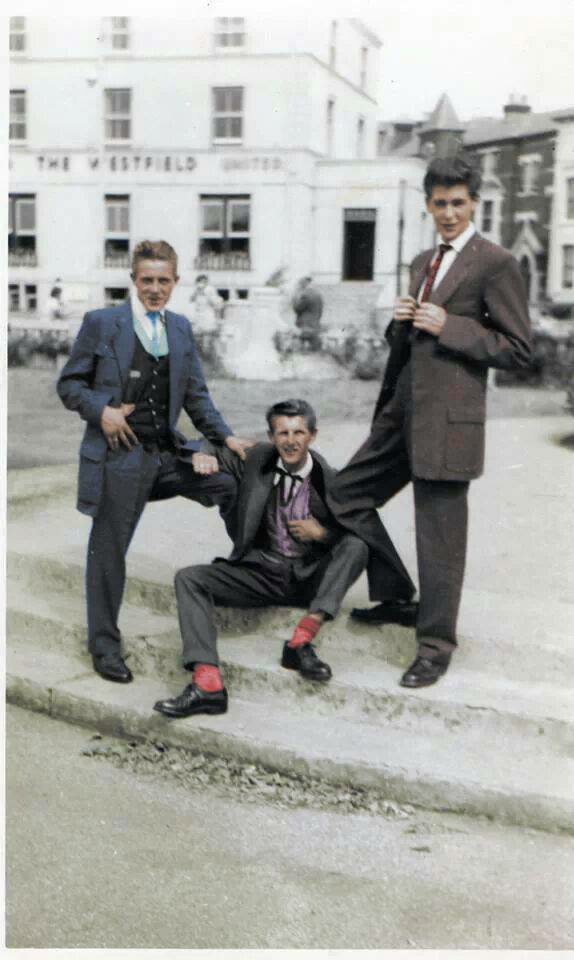
Three Teddy Boys - Left to right James Kemp, Frank Hulse and Peter Jackson (information kindly provided by Mr Hugh Finnegan) in smart Neo-Edwardian attire pose in the Park in front of the Westfield Hotel, Clarence Parade, Southsea near Portsmouth, Hampshire in 1956.
_____________________________________________________________________
The Real Teddy Boys of 1955 from Pompey!.
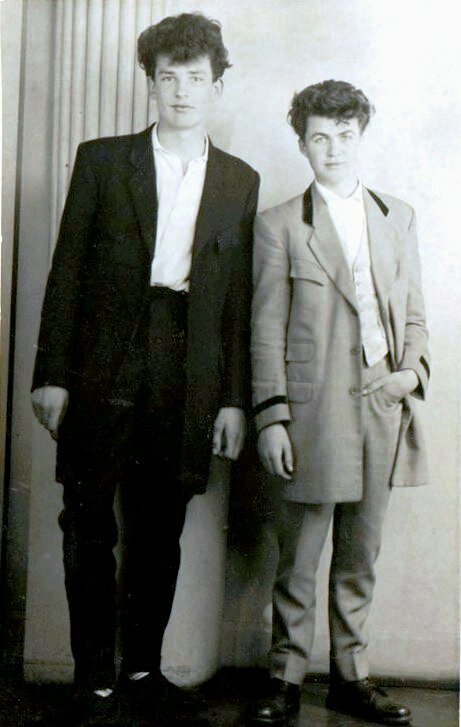
Two Teddy Boys who lived opposite each other from Somers Street, Southsea, Portsmouth: Eddy Rowlands with Hugh Finnegan taken at Jeromes Studios, Portsmouth in 1956. Copyright and Courtesy of Hugh Finnegan.
_______________________________________________________________________
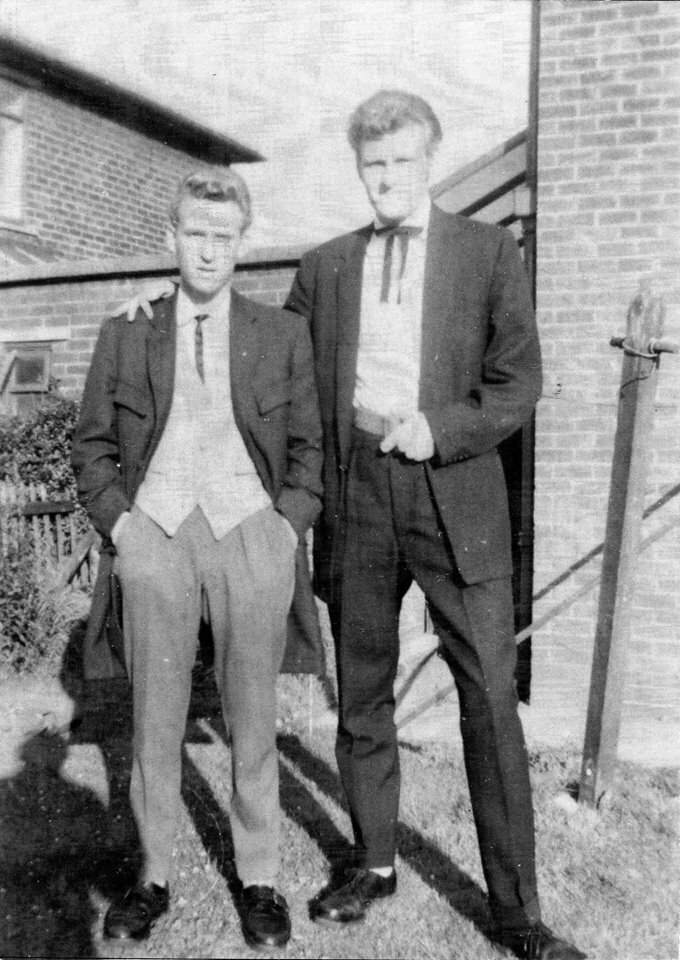
Two Teddy Boys photographed at Eccles, near Salford in Lancashire in 1958
_______________________________________________________________________
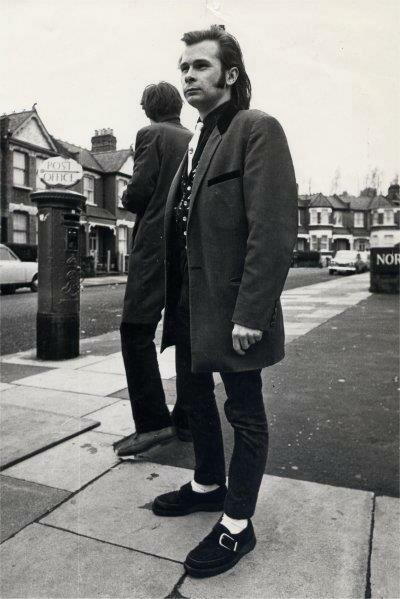
Keith Pinnell in full Ted gear - better known as the Disc Jockey, Fifties Flash outside Davis Dairy / Grocers at Northview Road, corner of Southview Road, Hornsey, London N8 (near Alexandra Palace) in 1968. (Location information supplied by Rick Milkman). Flash was one of the pioneering DJ's involved in the re-discovery of relatively unknown Rock n Roll Music from America and playing this to a developing new audience during the period from late 1960's through to the 1990's. Sadly Flash no longer DJ's as the result of a Stroke he suffered a few years ago.
____________________________________________________________
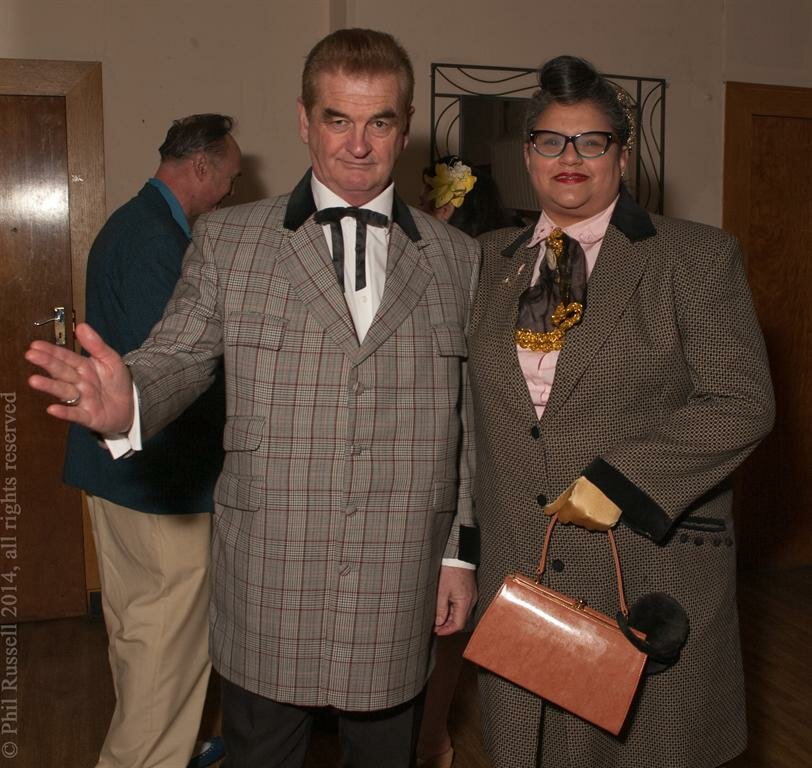
Nidge & Roseanne at the 'Fifties Flash' Benefit Night at the Dome, Tuffnell Park, North London on Saturday 11th January 2014 - taken by Photographer Phil Russell.
https://www.philrussellphotos.co.uk/Vintage_Lives.html
______________________________________________________________________
_______________________________________________________________________
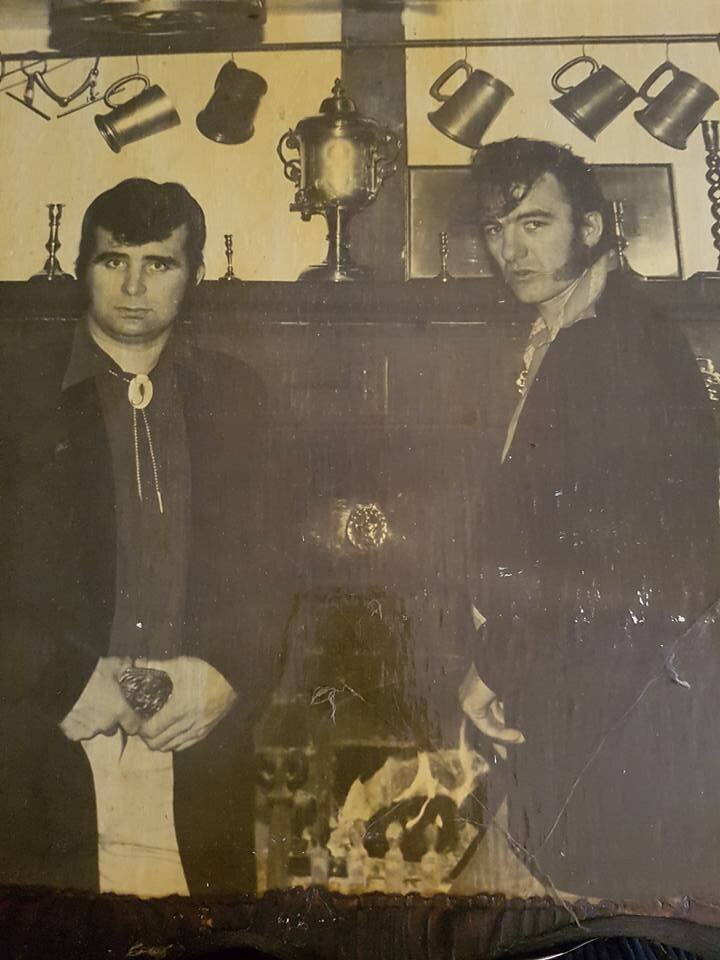
An early 1970's photograph of Mike Coffey (Drummer and brother of Breathless Dan Coffey) and Cavan Grogan, both life long members of the band, Crazy Cavan & The Rhythm Rockers. The band has been part of the Teddy Boy music scene since the early 1970's and who's own distinctive style of Rockabilly known as Crazy Rhythm has made them a Teddy Boy institution to this day.
_______________________________________________________________________

The Edwardian Teddy Boy is an official supporter of Crazy Cavan & the Rhythm Rockers.
The Official Crazy Cavan & the Rhythm Rockers Fan Club.
____________________________________________________________________
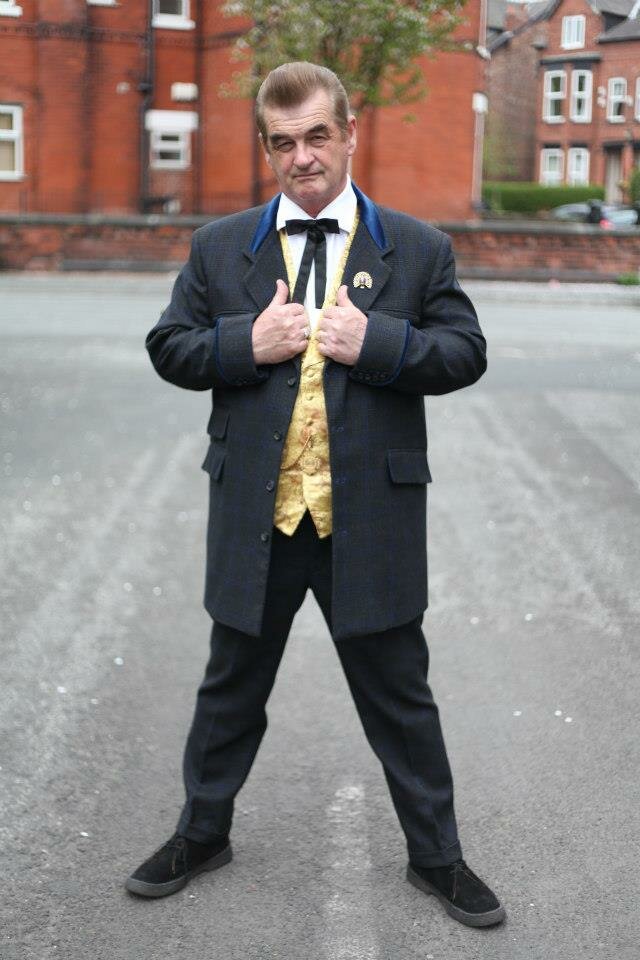
John aka Rockin Nidge at Chorlton-cum-Hardy, Manchester in May 2013 wearing a John Anthony Tailored two piece drape suit of Charcoal with Royal Blue window pane and blue velvet collar. The cuffs are turned back pirate cuffs of 3 1/2" with opening buttons with 4" lapels and 17" bottom trousers. Copyright: Rose van T Photography.
______________________________________________________________________
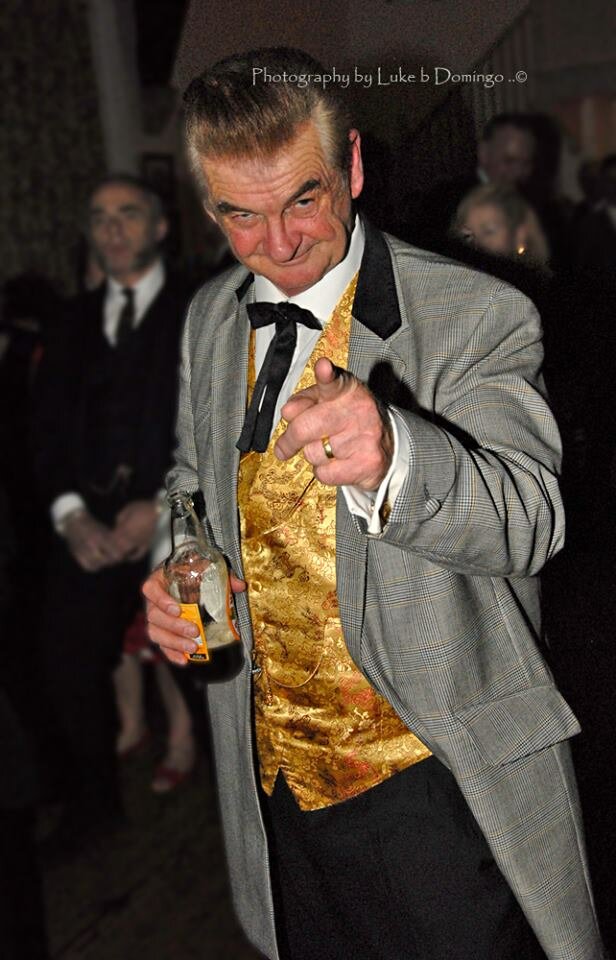
Nidge in a Prince of Wales Drape tailored by Steve Thompson Tailoring, Leeds with a Silk Patterned Gold Waistcoat, tailored by Kieth Wilson, Tailoring, Leeds at the British Rock n Roll Night, Tempsford, Bedfordshire, February 2016. Copyright Luke B. Domingo, Photography.
_______________________________________________________________________
"Murder, Mystery and My Family"
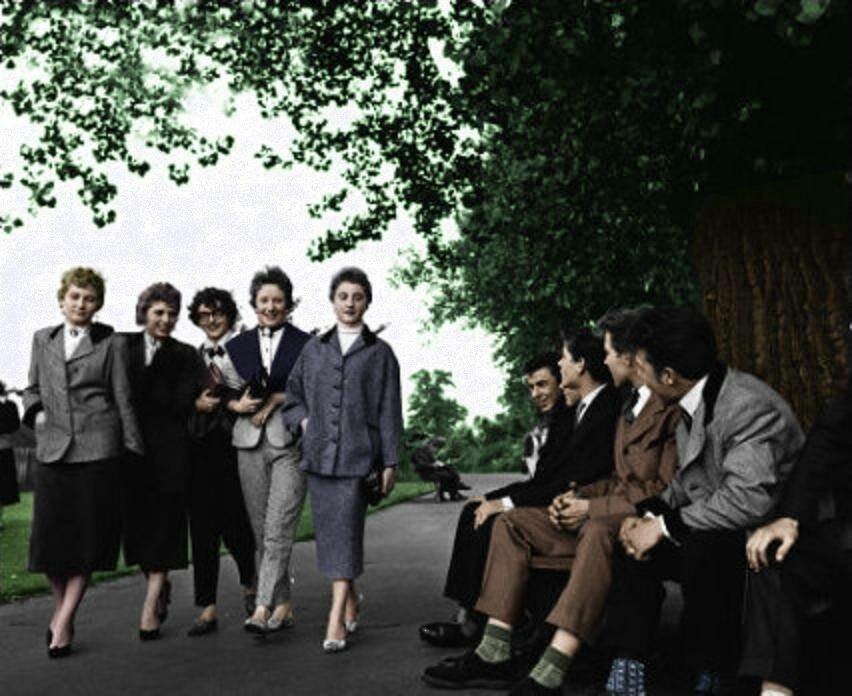
A colour version of the 1954 photograph of Teddy Girls and Boys on Clapham Common in 1954.
As many of you know already, John van Rheede Toas aka Nidge will be appearing in one episode of a new series, entitled "Murder, Mystery and My Family" which consists of 10 programmes which will air daily at 9.15am on BBC One from Monday 26th February until Friday 9th March. he was filmed for one of these episodes on the 1953 Teddy Boy Clapham Common Murder and in this episode he meets the niece and family friend of the accused murderer and leader of a local Teddy Boy Gang, known as "The Plough Boys", Michael John Davies. H then discusses the murder with these two ladies and they then walk the route accross Clapham Common where four boys from elsewhere in South London were chased by "The Plough Boys". One of the boys from Walworth, John Ernest Beckley was stabbed several times and later died of his wounds in Bolingbroke Hospital, Wandsworth after coming to rest outside Okeover Manor, a residential apartment block on Clapham Common Northside.
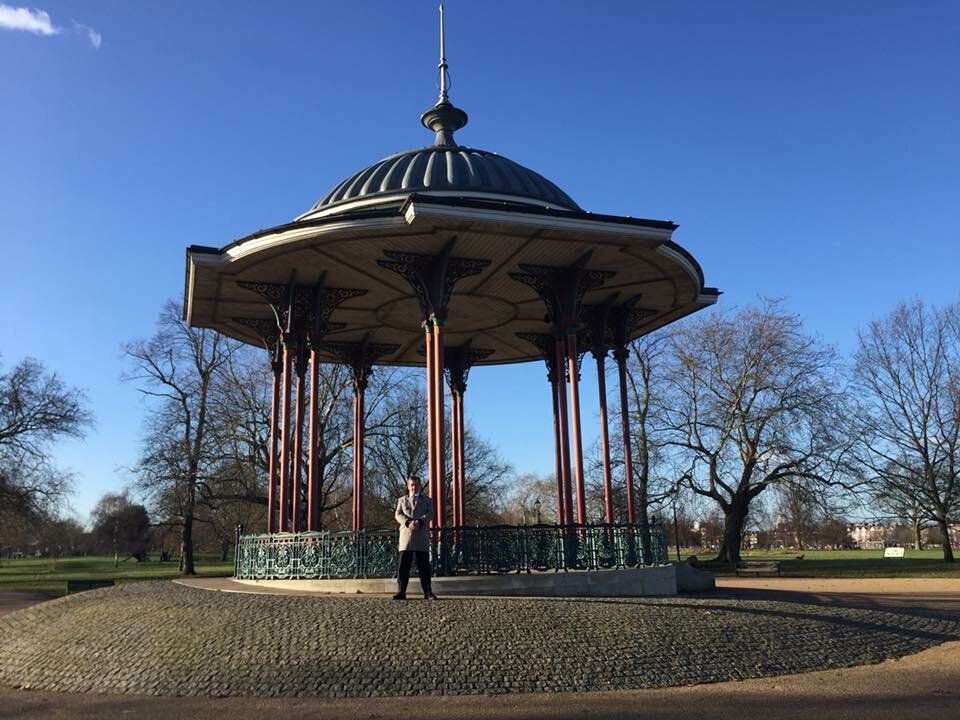
As the final order of episodes will not be decided by the BBC until very shortly before the episodes air, unfortunately it is not known which day the Clapham Common Teddy Boy Murder that concentrates on the trial, imprisonment and rescinded death sentence of "Plough Boy" leader Michael John Davies and in which Nidge is featured as a 1953 Teddy Boy will go out.
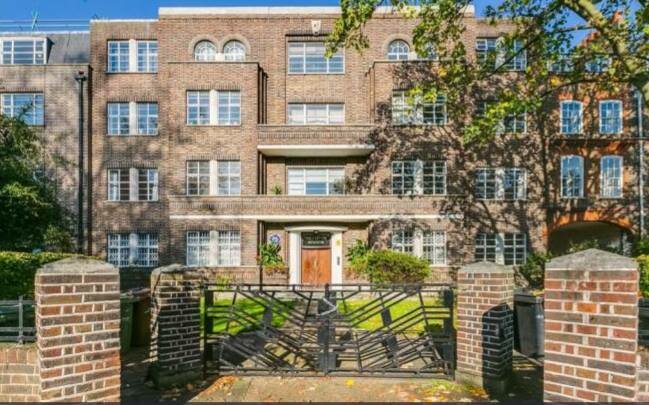
Okeover Manor, Clapham Common Northside where John Ernest Beckley (17) from Walworth came to rest after being stabbed several times by the Clapham Plough Boys Teddy Boy Gang on the evening of Thursday, July 2nd, 1953. He was later taken to Bolingbroke Hospital, Wandsworth where he died of his wounds that night.
The Series will be available on the BBC iPlayer

_______________________________________________________________________
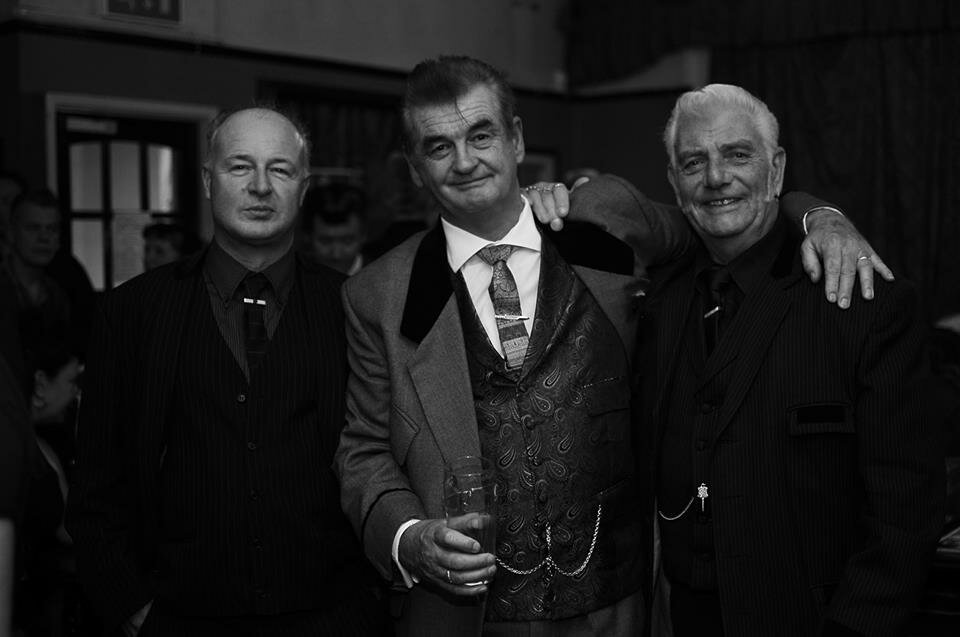
Teddy Boys, Tony Richards from Eastbourne, Sussex, Nidge and Gerry Shore from Bristol welcome you to the Edwardian Teddy Boy.
Welcome to
The Edwardian Teddy Boy
a British Cultural Icon
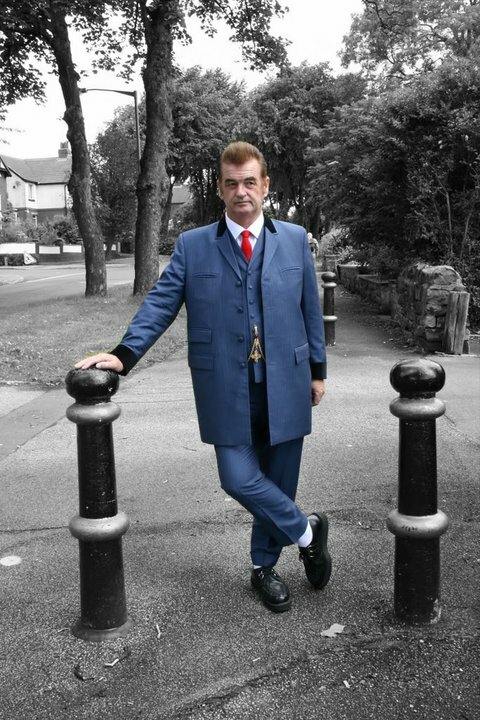
John aka Rockin' Nidge pictured next to the Horsforth Hotel (locally known as 'The Friendly') at Stanhope Drive, Horsforth near Leeds in the West Riding of Yorkshire wearing a blue mohair 3 piece Drape suit made by the late Peter Smithard of Holbeck, Leeds. Copyright Rose Van T. Photography, Manchester.
______________________________________________________________________
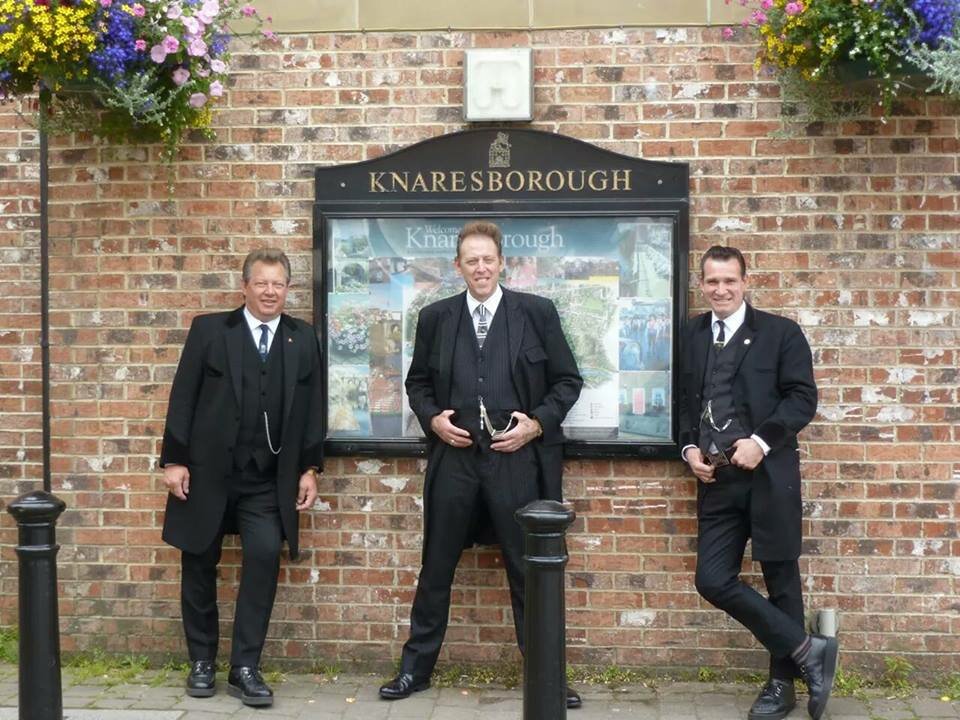
Teddy Boy's: Martin Gravill from Leeds, Steve Moore from Dewsbury and Billy Perry (originally from Reading) also from Leeds on an outing in Knaresborough, Yorkshire in the Summer of 2014. Courtesy: Steve Moore.
_______________________________________________________________________
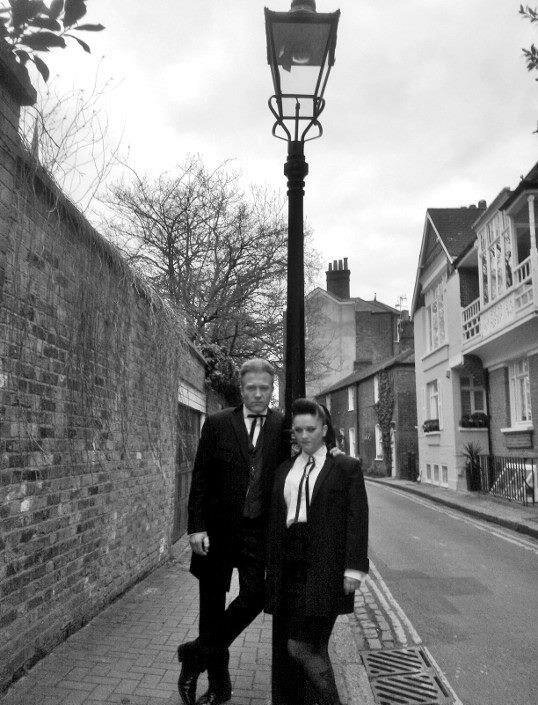
Teddy Boy Paul and Teddy Girl Anja from London sporting the original style in Hampstead in March 2013!
______________________________________________________________________
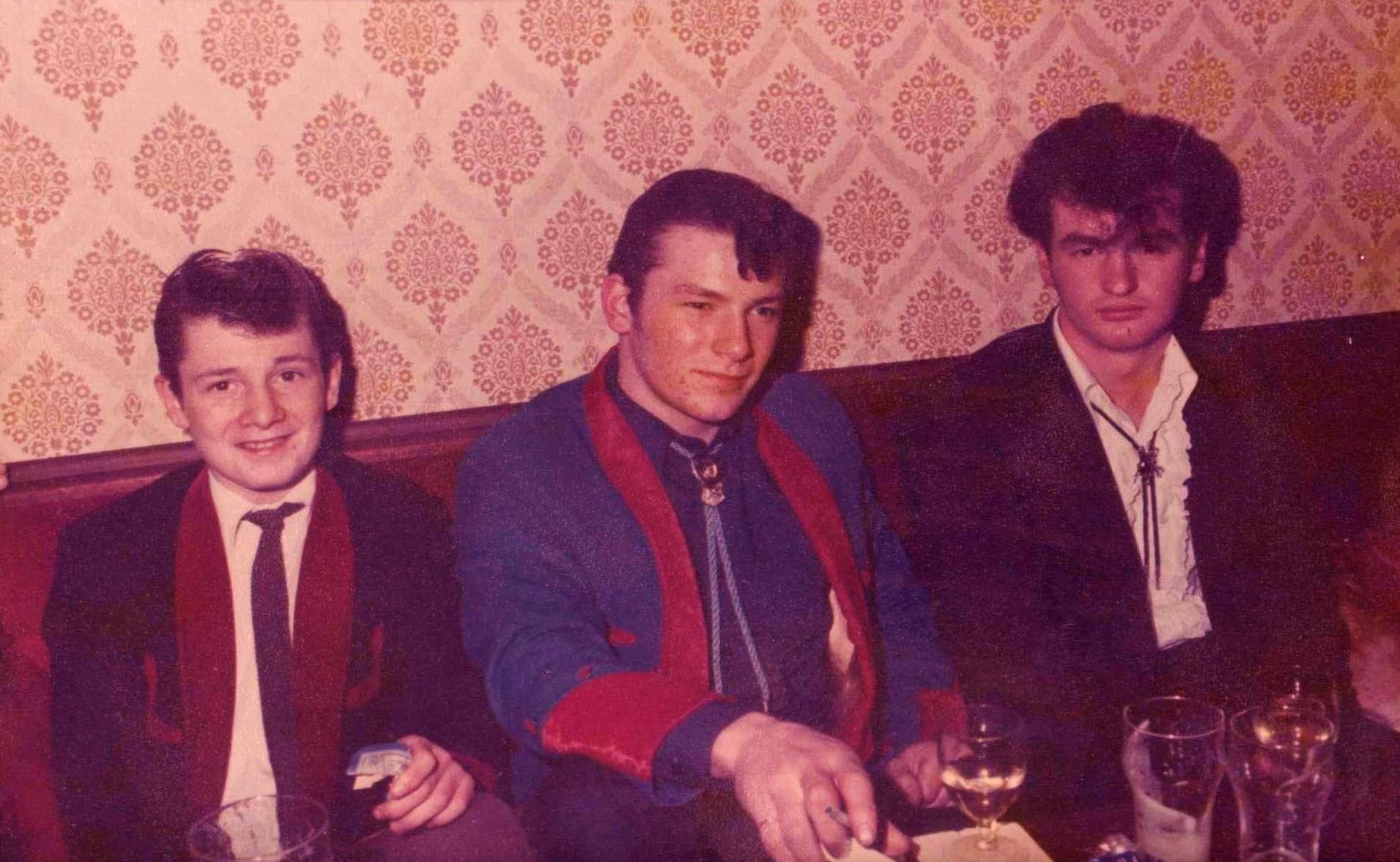
_______________________________________________
A Brief history of the Teddy Boy Movement
A Cultural Icon - the Great British Teddy Boy
"The emergence and the story of the Working Class Edwardian"
John van Rheede Toas aka Rockin Nidge
The origins of the Teddy Boys actually go back to the late 1940's when Saville Row Tailor's attempted to revive the styles of the reign of King Edward VII, 1901-1910, known as the Edwardian era, into men's fashions. The Teddy Boy fashion of the fifties has its origins in what was an upper class reaction to the austerity imposed by the socialist government in the years following the World War II. The style of dress was addressed, primarily, to the young aristocratic men about town and not young working class youths.
Although the popular press of the day claim that the working-class Edwardian fashion was initially worn in south and east London during the early 1950's, the fashion was actually taking hold all over the country at the same time. Examples of this can be found in Newspaper reports and Photographs which confirm this.
In 1953, the major newspapers reported on the sweeping trend in men's fashion across all the towns of Britain, towards what was termed the New Edwardian look. However the working class Edwardian style had been on the street since at least 1951, because the style had been created on the street by the street and by working class teenagers and not by Saville Row or fashion designers such as Hardy Amis.
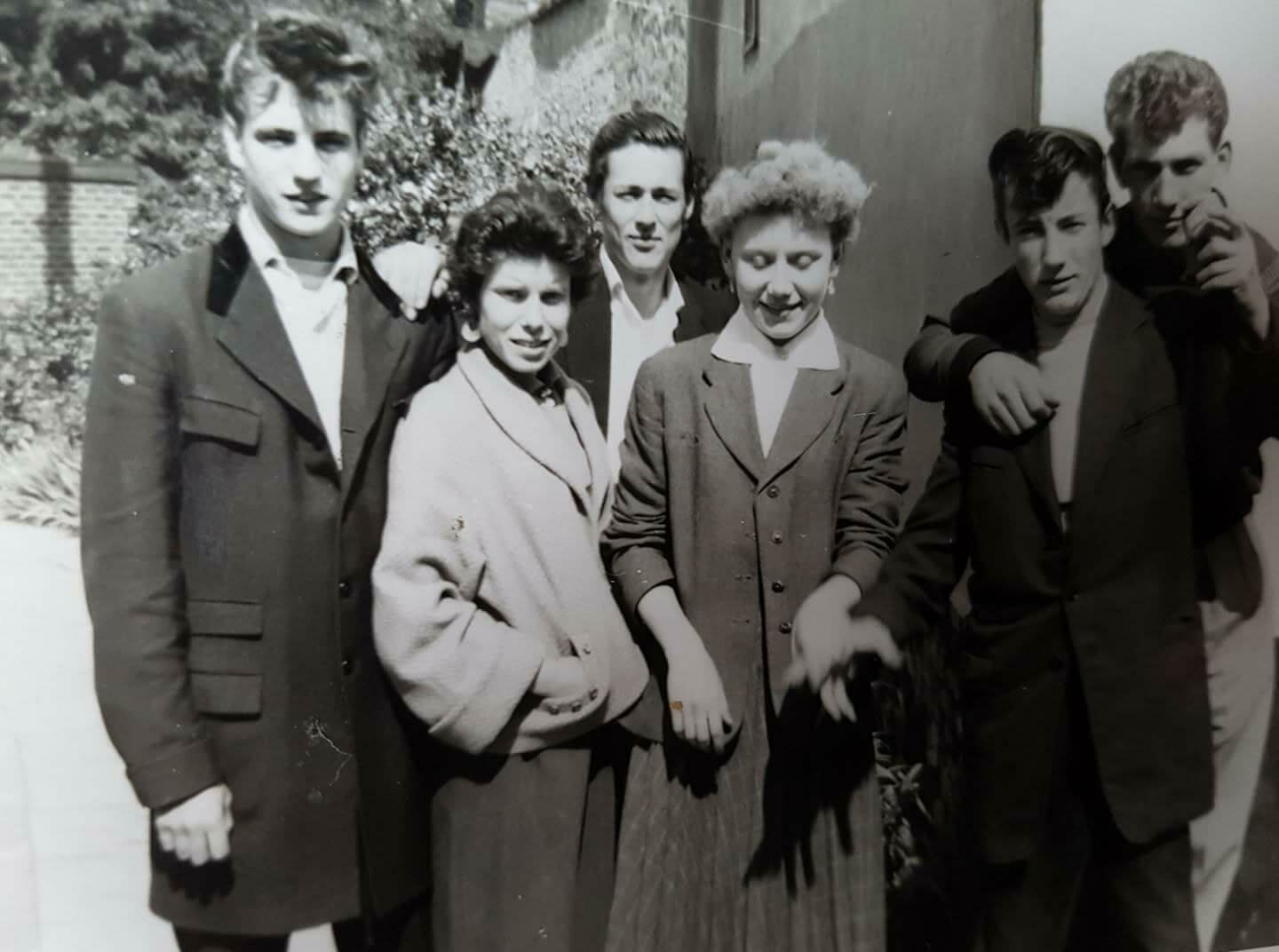
Uxbridge Teddy Boy Eddie Chenneour and his friends outside the Hillside Cafe in High St, Uxbridge, Middlesex in the late 1950's.
The name "Teddy Boy" however, was not officially born until September 23rd 1953 when a Daily Express newspaper headline shortened 'Edward' to 'Teddy' and coined the term 'Teddy Boy'. Nevertheless, it is also known that a number of girlfriends of working class Edwardian's (Teddy Girls) were referring to them as Teddy Boys well before the Daily Express used its media power to officially christen Edwardian's into Teddy Boys.
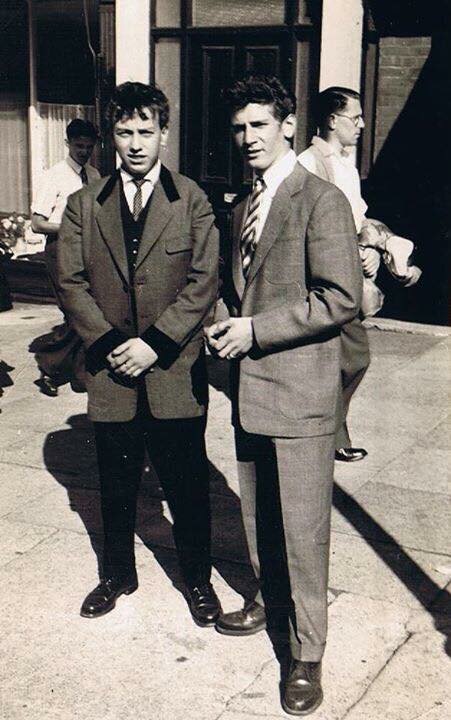
A Carlisle Teddy Boy and his friend pictured in the mid 1950's wearing a sloped lapelled Drape Jacket and Oxford Shoes.
The Teddy Boy is a uniquely British phenomenon and pre-dates the introduction of American Rock'n'Roll music into Britain in late 1955 by Bill Haley & his Comets by at least five years or so. However, one fact is clear, that when Rock 'n' Roll did hit Britain like a thunderbolt in 1955, the music would quickly become adopted by Britain's Teddy Boys and from that point onward's the style and the music became inseparable.
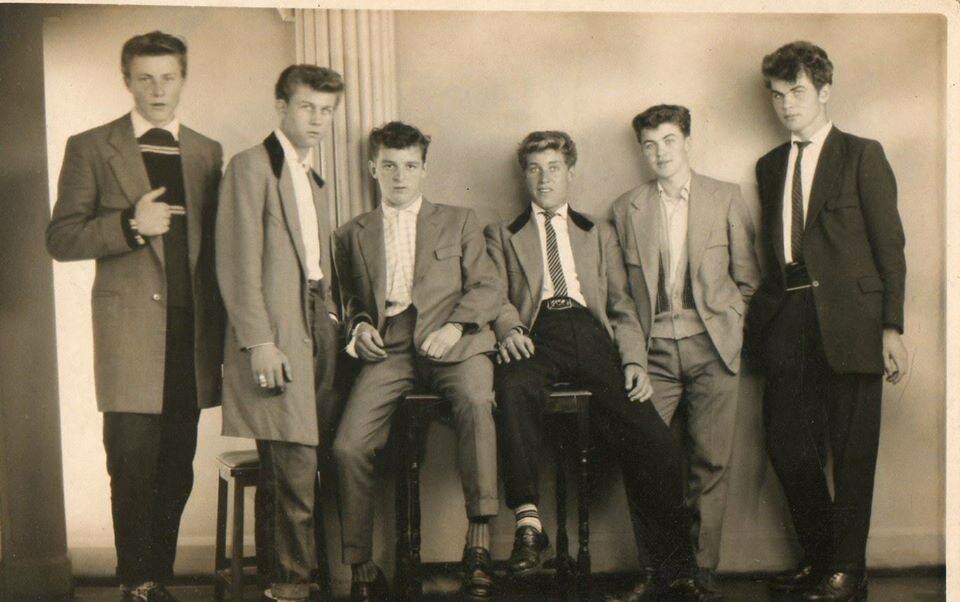
1955/56 - Portsmouth Teddy Boys: (Left - Right) Albie Deacon, Johnny Moor, Graham Butcher, Brian Frost, Hugh Finnegan, and Eugene Finnegan. Jerome's Studios, Commercial Road, Portsmouth (Photograph courtesy and copyright of Mr Hugh Finnegan)
The Teddy Boy style was probably at its peak between 1954 and 1957, however by 1958 the Italian look had started to come into fashion for young men which was characterised by short bum-freezer jackets and narrower lapels and tighter trousers. The era of the Teddy Boy was rapidly fading and by 1960 a new set of teenagers were joining the new emerging cults such as the Modernists and the Rockers.
Britain's Teddy Boys nonetheless never faded away completely and during the 'dark days of the 1960's', small groups of Teddy Boys kept the movement going. Many Teds had 'got married and settled down' while others had joined the ranks of the leather jacketed Rockers.
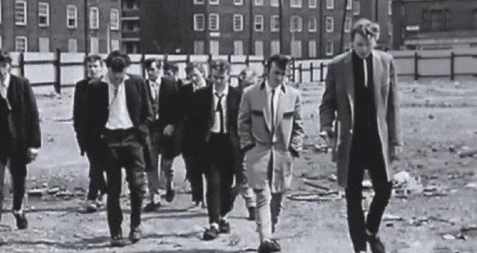
This film clip was taken from the BBC 2 Documentary, Where have all the Teddy Boys Gone. These are the "Harra Boys" at Sheepcoate Road, Harrow in 1968. The Documentary was first broadcast on Sunday 3rd August 1969 on BBC 2 at 21.30 in the evening, although it was actually filmed in 1968 and featured five former Teds - George, Mick, Mike, Len and Bernie who recall the frustrations and battles of Britain's first 'teenagers'.
The loyalty of these die-hard Teds who carried the movement on through the dark days of the 1960's paid off because by 1967, Bill Haley & the Comets were back in the charts with Shake, Rattle & Roll and the so-called Rock n Roll revival had arrived and by the 1970's a new generation of Teddy Boys came about.
The 1972 London Rock n Roll Festival was a milestone in the re-emergence of Rock n Roll and a whole host of American Rock n Rollers delighted a whole new generation of Teddy Boys with Bo Diddley, Jerry Lee Lewis, Bill Haley, Little Richard and Chuck Berry appearing alongside Britain's Heinz and Screaming Lord Sutch.
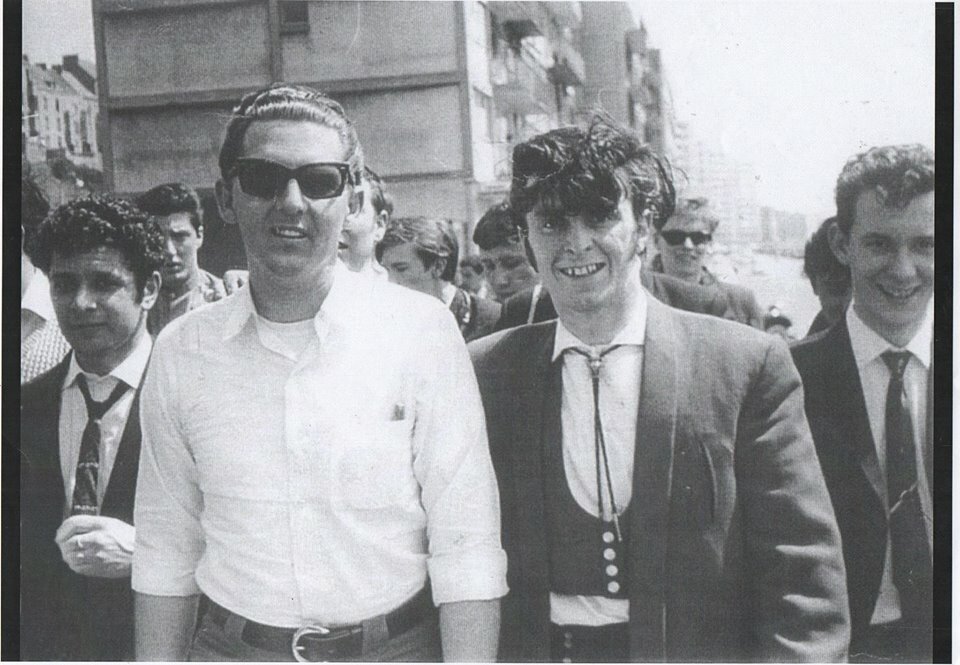
Jerry Lee Lewis with Breathless Dan Coffey - in Boulonge-sur-Mer, France ready to do the Rockin' accross the Channel concert in May 1963.
One notable original Ted, Breathless Dan Coffey from Newport in South Wales was largely responsible for not only keeping the movement going during the 1960's, but for introducing 'Rockabilly' music into Britain from the Southern States of America. Rockabilly eventually became the mainstream music of the Teddy Boys during the 1970's. New bands started such as the Wild Angels, Rock Island Line, Shakin Stevens & the Sunsets, the Riot Rockers, Crazy Cavan & the Rhythm Rockers, Flying Saucers and Matchbox to name but a few. Rock 'n' Roll was also appearing in the charts albeit in a populist diluted form. Original Rockabilly and Rock n Roll artists were also having new leases of life, such as Carl Perkins, Charlie Feathers, Warren Smith and Sonny Burgess. One of the most obscure records to come out during the seventies and become a hit was Hank Mizell's 'Jungle Rock', which had never been heard before in the UK.
This new generation of Teddy Boys, some of whom were maybe the sons of the originals and others who did not want to hang around with the other tribes and were simply sick and tired of the fashions that were around at the time multiplied and Teddy Boys and Girls could be seen once again back on Britain's streets. Teddy Boy pubs and clubs could be found back in all of Britain and Ireland's major towns and cities. One of the most notable London Ted Pubs was the 'Black Raven' in London's Liverpool Street where many well known Teds hung out such as the legendary 'Sunglasses Ron'. In terms of dress, the 1970's Teds however adopted much brighter coloured Drape Jackets and Suits than those that were worn back in the fifties and many were influenced by the Glam Rock era that existed during the 1970's. Nevertheless, the 1970's was a renaissance period for Britain's Teddy Boys.
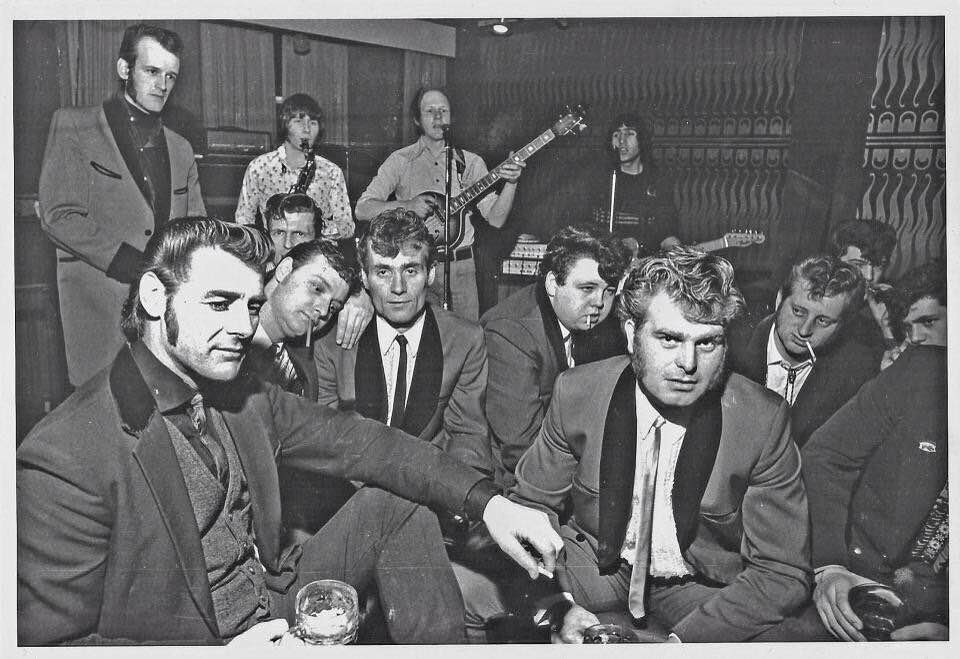
Cambridge Teddy Boys pictured inside 'The Rock' Hotel on Cherry Hinton Road, Queen Edith's, Cambridge in 1973. Pictured in the front left is the late Lenny Wilshire an original Ted who also frequented the Black Raven at Bishopsgate in the East End of London in the late sixties and early seventies. These Teds are dressed in Drapes typical of the late 1960's early 1970's.
One major event happened in the 1970's which brought Teddy Boys to the fore nationally, was the 'March to the BBC' and this took place on Saturday 15th May 1976. This involved thousands of Teddy Boys and Girls from all over the Country marching through Central London to the BBC studios in a national campaign for more Rock 'n' Roll to be played on the Radio. The campaign was a total success and the BBC caved in and this resulted in Harrogate born Stuart Coleman who had helped organise the march and much to his surprise into delivering a weekly Rock n Roll Show on Radio 1 late on Saturday afternoons. The March was followed by a big concert at Pickets Lock Sports Centre in Edmonton, North London where hundreds of Teds danced to the Hellraisers, Crazy Cavan & the Rhythm Rockers and Flying Saucers - an LP Record was made of the Concert entitled Rock 'n' Roll is Still Alive.
Towards the end of the 1970's some of the younger Teds became disillusioned with the Ted scene due to a number of factors and two new groups evolved. The first were the Rockabilly's who wore check shirts jeans and Donkey Jackets. The second were the Hep Cats who were generally much younger than the Teds and had started to adopt the American 1950's look and were into Swing Jive and fast Doo Wop.
Unfortunately, by the late 1980's the Teds were on the wane once again and many had done what their forebears had done in the late fifties and had got married and settled down. Others had left the ranks of the Teddy Boys altogether and joined the Rockabilly's and the Hep Cats as already mentioned.
Nevertheless, they were always the die-hard Teds, and these stalwarts kept the movement going. During the 1980's a small number of Teddy Boys were starting to re-evaluate themselves and had got fed up with the Teddy Boy style of the seventies and started to look back into the origins of the movement. As early as 1981 a small group of Teds in Eccles, Lancashire and later at Farnborough in Hampshire had started to adopt the styles of the pre 1955 Teddy Boy. The pre 1955 look composed of suits of darker and more conservative shades with wider lapels of 3½"-4" with velvet only present on the collar and sometimes the cuffs or with no velvet at all. The trousers were pleat fronted with turnips and 16"/17" bottoms and the waistcoats were either brocade or plain and complemented by a pocket watch and chain.
Later, in 1994 two sisters, Dixie & Susie Coombs formed T.E.D.S. - the Edwardian Drape Society at the Empress of Prussia pub in Islington, North London with the objective of taking a co-ordinated approach at encouraging those Teds still around to start wearing a more authentic form of Teddy Boy clothing and to reclaim the original 1950's Teddy Boy style. This group which was later headed by well known North London Teddy Boy, Ritchie Gee had a lasting effect and influence on the the Teddy Boy movement. As another well known Teddy Boy from North London says: "It's great what The Edwardian Drape Society set out to do back then in those days, because this had a permanent lasting effect on putting our image right."
Another factor that has changed along with the Teddy Boys dress style has been a big interest in British Rock n Roll music in place of Rockabilly. Many of today's Teds are now listening to the sounds of Tommy Steele, Tony Crombie, Vince Taylor, Shane Fenton and Johnny Kidd & the Pirates. There are now a number of bands on the scene who are playing the British Rock n Roll of the late 1950's and early 1960's such as The Rapiers, The Fireballs and Serious Charge.
Most of the Teddy Boys around today are third generation Teds and the nineteen seventies was the period that they became active on the Teddy Boy scene. There are also a few second generation and fourth generation Teds and even a small number of new recruits from the current period. Due to the fact that many of these Teds are in their late forties, fifties and sixties, their style of dress has been toned down with the passing of years and is totally different to what many would have worn in the 1970's. Despite this, there is nevertheless a number of Teds who like to maintain the brighter 1970's look and still prefer to wear the drapes that they would have worn then, which is their right of course.
Despite the variety of styles and differences in opinions within the Teddy Boy movement, one thing is for sure, the British Teddy Boy is likely to be around for a good few years to come and represents the first distinctive style that made teenagers in Britain stand out and be different from the rest. The Teddy Boy's were the originators of a distinctive Youth Culture in Britain and the first rebels against conformity and conventional style. They have continued to maintain that reputation to this day, standing out from the rest of society - the British Teddy Boy really has become a British Cultural icon!
_______________________________________________
The style evolution of the Teddy Boy
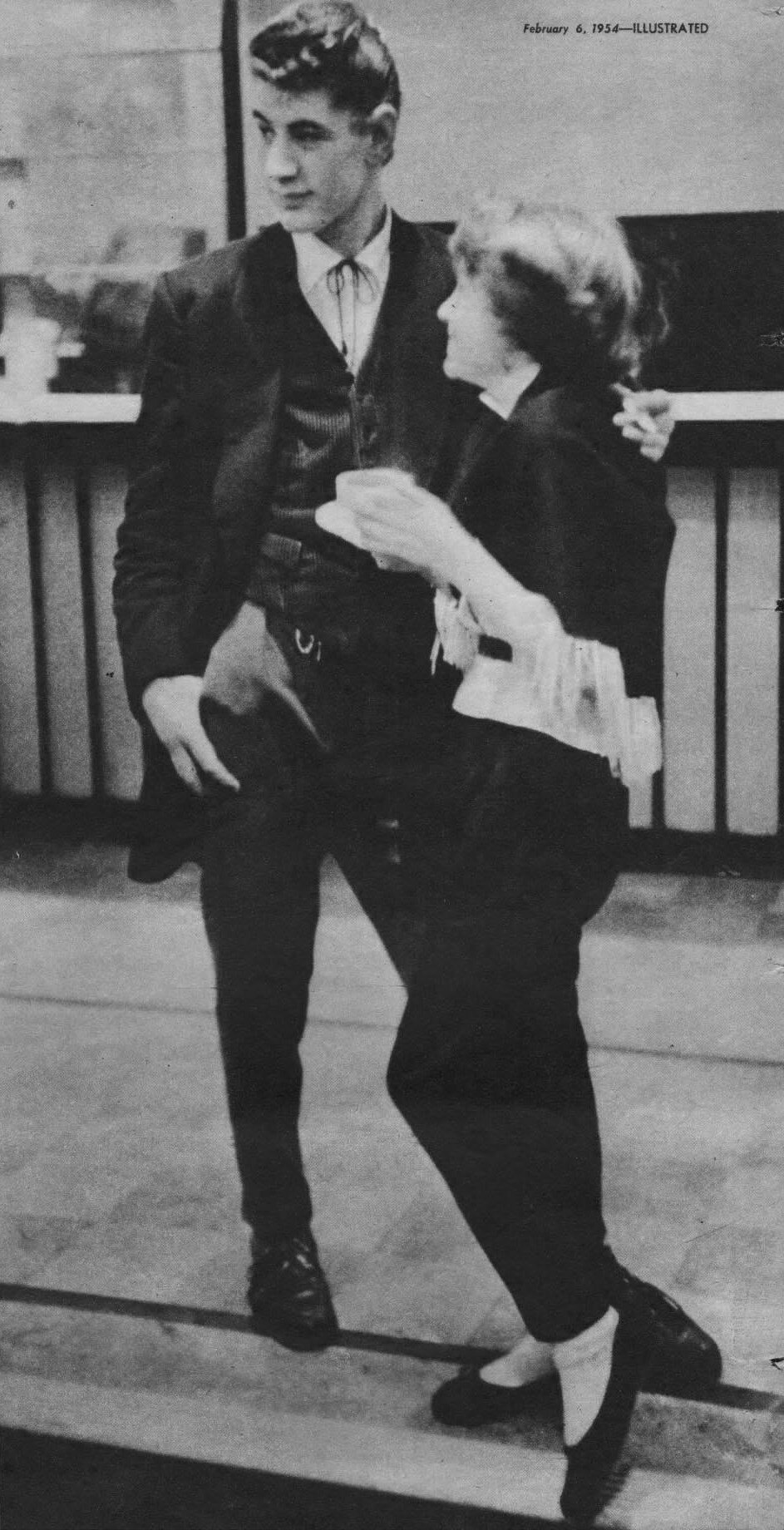
Derek Keates (known as "The Sheriff" due to his Western Gambler image) with girlfriend Valerie Kitts at a Best Dressed Teddy Boy Competition in 1954 who is wearing a rolled collar Drape Jacket with half-moon pockets with full velvet trim and wearing a genuine "Bootlace Tie".
This period is when Ice Blue, Maroon and Bottle Green drape suits became popular with mainly black velvet trim, although other coloured velvet's were used, particularly blue. This particular style would then set the scene for the re-emergence of the Teddy Boy some 10 years later in 1967 when the identical style became re-adopted. Although the so called Rock n Roll Revival started in 1967, there was always an underground Teddy Boy movement which continued throughout the 1960's largely due to stalwarts like Breathless Dan Coffey and Boppin' Brian Spilsbury, to name but a few!
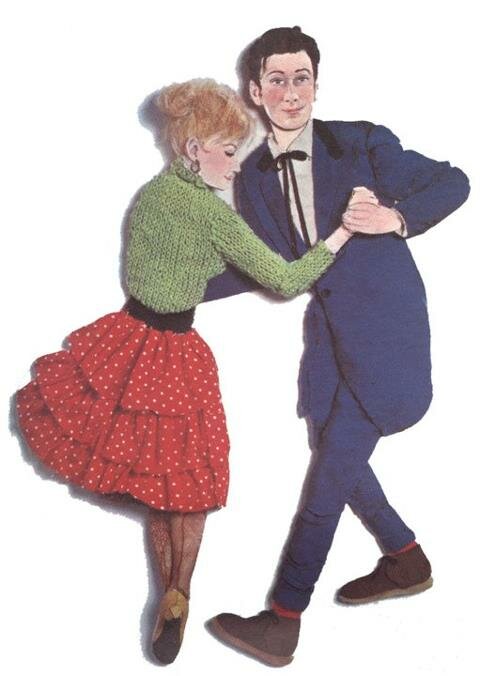
However, during the 1970's, the Teddy Boy style had become somewhat bastardised compared to the original Edwardian Teddy Boy of the early to mid 1950's where jackets were characterised by much more sober colours of black, grey, navy blue and plaid checks.
https://www.britishpathe.com/video/teddy-boys/query/
This 1970's Glam Rock image was started when fashion designer Vivienne Westwood had started making glam Teddy Boy clothing for Malcolm McLaren and in 1971, they opened a shop called 'Let it Rock' at 430 Kings Road, London.
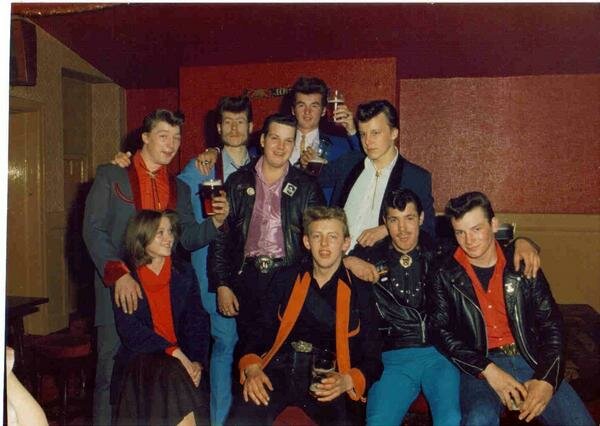
A group of Leeds Teddy Boys in the 1970's showing the different coloured velvets, use of roll collars and half-moon pockets which were very popular at the time. Note many Teddy Boys at this time would also wear Leather Jackets which were a spin off from the Rockers of the 1960's, however these would be generally worn during the days with Drapes being worn during the evenings.
As a result, many of the 1970's drape jackets were heavily influenced by this glam rock image which had perpetuated 1970's popular culture and much brighter colours were then worn. These colours included Scarlet Red, Royal Blue, Canary Yellow and in some cases the jackets had Lurex and Leopard skin trim in place of velvet. Generally however, greater use of velvet however was worn on both collars, pockets and cuffs, all in velvet of varying colours. One of the most popular designs worn by Teds in the seventies was black drape jackets with red velvet trim, however black velvet still predominated as being the popular trim.
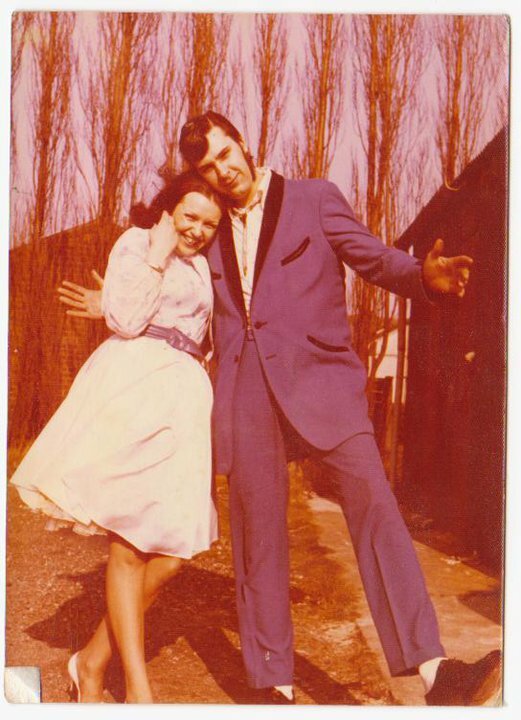
Lynda Gedge originally from Horsforth near Leeds with Dave Cass from Doncaster circa 1975. Dave sadly died at the very young age of 27 - R.I.P. "Cass" is wearing a Royal Blue Drape two peice with black velvet rolled colllar, half-moon pockets and black velvet "Vandyke" cuffs. Dave has turn-ups on his trousers.
The use of Vandyke cuffs on Drape Jackets became popular. There was also a predominance of drape jackets with velvet rolled collars and velvet edged half-moon pockets. Trousers were generally of 14" bottoms with very few who would wear turn-ups. Many Teddy Boys in the 1970's were wearing Bootlace (or Bolo) ties with their suits as opposed to 'slim jim' or 'maverick' ties worn in the 1950's.
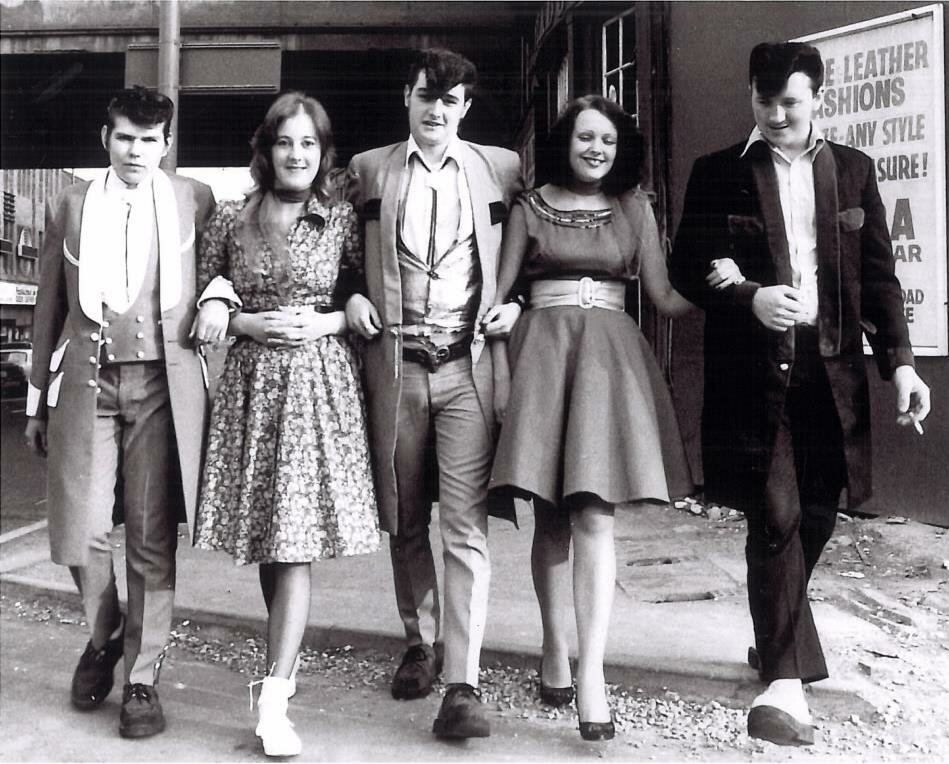
Leeds, 5th July 1976 Rock and Roll line up from left: Henry Karasiewicz 25 Kirkstall, Julie Skelton 18 Horsforth, Nick Kovrlija 21 Halton, Lynda Gedge 18 Horsforth, and Terry Best 25 Roundhay. Henry is wearing a Scarlet Red Drape trimmed with White/ Silver Lurex, Nik is wearing a dark Yellow Drape with Black Velvet pockets and Terry is wearing a Black Drape with Blue Velvet. Apart from Henry, the other Teds are wearing the squared-off Roll Collar which was influenced by Big Gerry Townes older brother Rocky Townes who wore a similar style of Drape back in 1959 - very much a Leeds individual style.
As time went on, an interest steadily developed amongst pockets of Teds into to reclaiming the original 1950's style. This started in the 1980's amongs't those Teddy Boys, who had become disillusioned with the outfits of the 1970's. This original style was found to have little in common with the Teddy Boy Glam Rock influenced outfits of the 1970's. These small pockets of Teddy Boys and Girls at this point in time became pre-occupied into researching the styles of the original Edwardians. They realised that they wanted to go back to the roots of the original pre-1955 Edwardian's and wanted to wear Teddy Boy outfits and adopt the look of 1953/4.
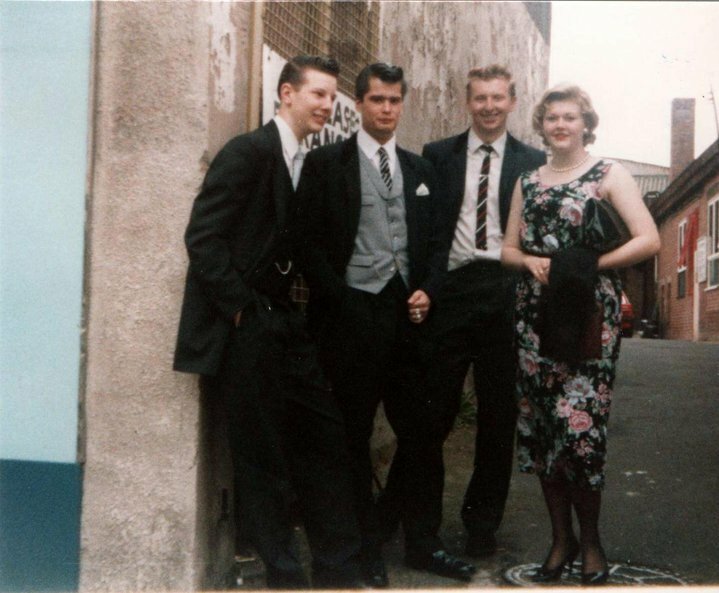
Farnbourough 'Edwardians', Richard Wooley, Paul Culshaw, Simon Moon and Fiona somewhere in London in 1986 - they, along with others, had started to reclaim the original style.
This original Edwardian look comprised of wearing more sober colours with far less velvet trim, with velvet on the collar and maybe on the cuffs, but with no velvet on the pockets. Many original drape jackets featured no velvet trim and these same Teddy Boys were also then starting to have Drape Jackets tailored with no velvet at all.
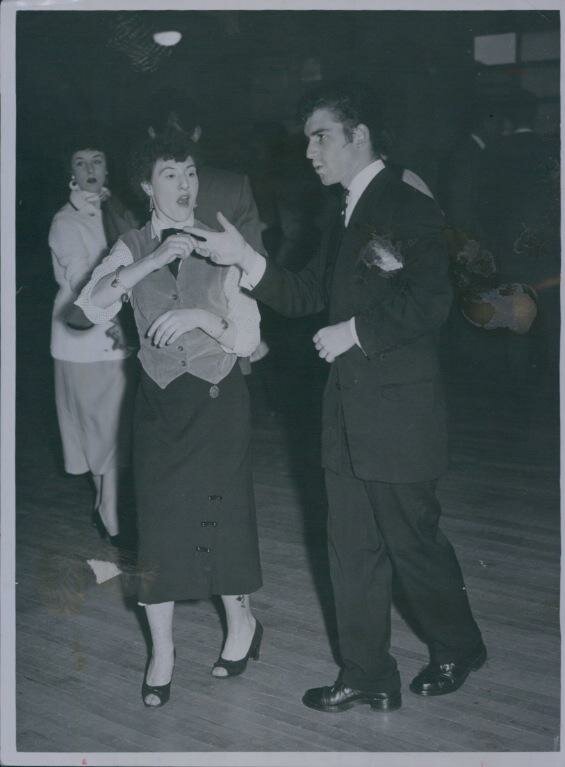
Teddy Boy Johnny Gard dances with a "Judie" (Teddy Girl) in a London suburban Dance Hall, 1954.
The photograph above of Johnny Gard, exemplifies the style that a number of 1980's Teds were attempting to emulate, which many did very successfully as you will see in the above photograph of Paul Culshaw and the Farnborough Edwardians taken in Birmingham in 1986. However as 1980's Teddy Girl, Susie Prince recalls, there was no internet (like now) that had images of original Teds and the research of the original Teds had to be done by purchasing copies of photographs from establishments such as the Victoria and Albert Museum in Central London. This was often the only method of obtaining images of original Teds at that point in time.
The original pre 1955 style jackets featured wider lapels of 31/2" and 4" with the trousers featuring pleated fronts and wider 16" bottoms with turn ups. The move towards this original style has continued and many Teddy Boys are now wearing a much more authentic style of dress as opposed to the Glam Rock image made popular in the 1970's. One the main purposes of this website is to perpetuate this original 1953/4 image amongst the Teddy Boy movement.
The principal main effort, of the Edwardian Teddy Boy website however, is to collect as much historical information and photographs on Teddy Boys as possible in order to become the prime source of information on the movement. This includes the 1970's so called Teddy Boy revival, as this is as much a major important period for the Teddy Boys as the 1950's.
Therefore if you have any historical data or photographs that you would like to donate to this site, please send it to Nidge at: shanganipatrol@ntlworld.com You will be credited with any information or photographs that you supply and if you want to loan these for scanning, they will be returned to you in the same condition that you sent them.
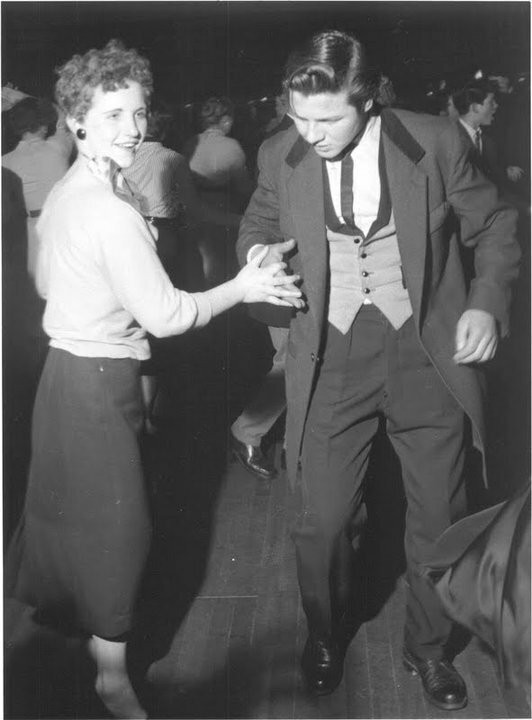
In terms of history and to understand how the original Edwardian style emerged, we need go back to the late 1940's, just after the Second World War. Teddy Boys or Edwardians (as they were first called), first began to appear in the early 1950's on the streets of South and West London after the style had become adopted by working class youths. The style had originally appeared in the late 1940's when Saville Row Tailors attempted to revive the styles of the reign of King Edward VII, 1901-1910 into men's fashions. The Teddy Boy fashion of the fifties had it's origins in what was an upper class reaction to the austerity imported by the socialist government in the years following World War II.
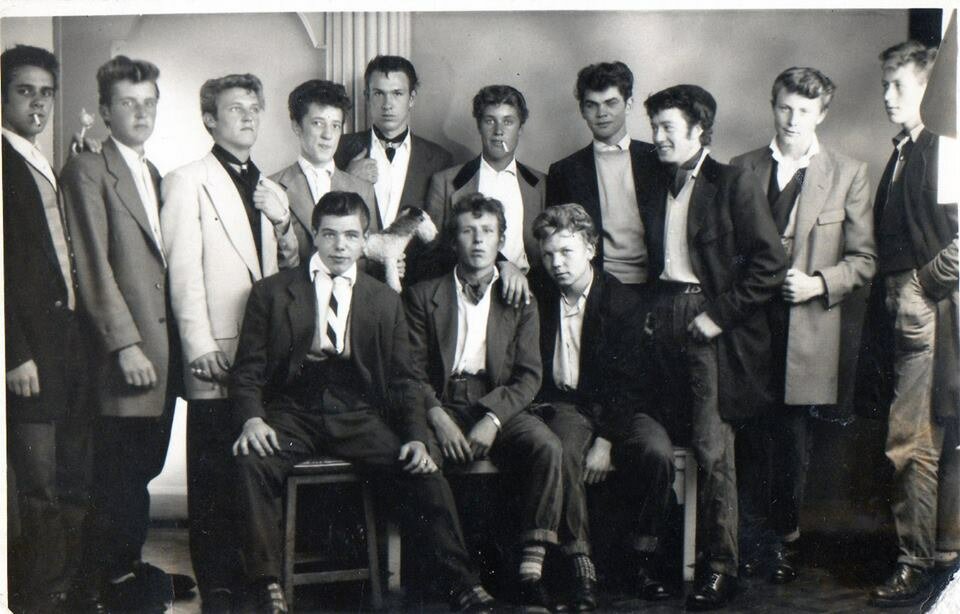
1956 Photo shoot on a Saturday Afternoon in Pompey. Original Southsea Teddy Boy, Hugh Finnegan recalls: "Not much else to do in them days, had to wait till 7.30pm for any dance halls to open, also pubs opened at 6pm and closed at 10.30pm but we still had a good time!!"
However the newly established working class 'dandified street gangs' with their extravagant dress and defiant pose made Teddy Boys popular subjects for the media in the 1950's. Like the Spiv of the Second World War, the Teddy Boy became a media folk devil and ended up as the scapegoat for anything to do with juvenille delinquency. The media in their efforts to vilify the great British Teddy Boy unwittingly spread the image far beyond the London area, until the Teddy Boy became a nationwide teenage style and the first post-war teenage subculture in Great Britain and Ireland.
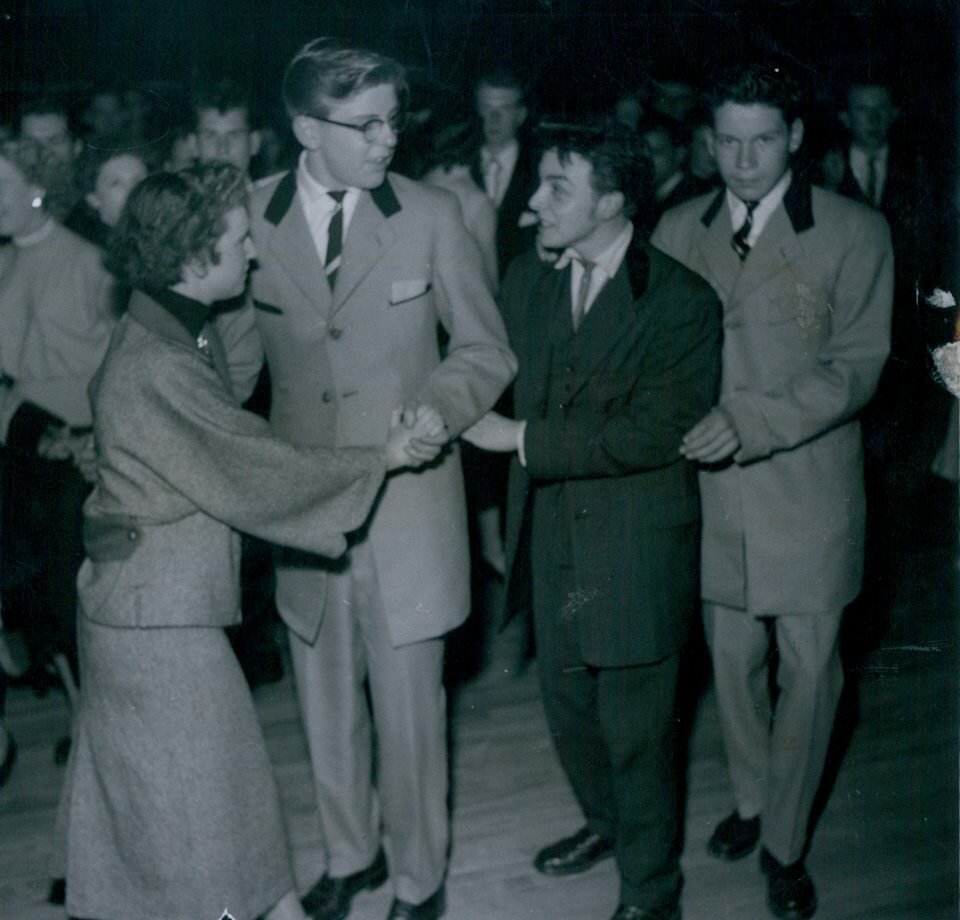
THE MORMON CREEP CUDDLE at the Mecca Royal Dance Hall, Tottenham, Middlesex. In this dance each girl has at least two partners. Psychologists think that the cult (Teddy Boys) which favors such dances as the Mormon Cuddle Creep in which a girl has several partners, is the aftermath of World War II with its separation of families and bombing neurosis. It is also a revolt by "young braves" against a drab post-war existence.
The Edwardian Teddy Boy website is run for the benefit of all British Teddy Boys and Teddy Girls who have continued to maintain this great British distinctive style and tradition.
One of the principal aim's of the Edwardian Teddy Boy is to promulgate the original styles of the pre 1955 Teddy Boy and actively promote the ethos and style of the original and authentic British Teddy Boy movement.
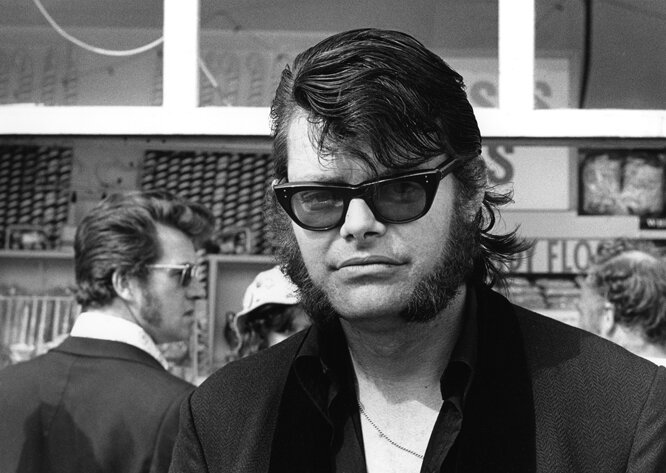
The Legendary 'Sunglasses' Ron Staples at Southend-on-Sea in the 1970's
It also aims to research, document and promote the entire history and continued existence of the movement including the so called revival of the late 1960's and 1970's and styles of this period along with the influence of Rockabilly music among'st the movement during that period.
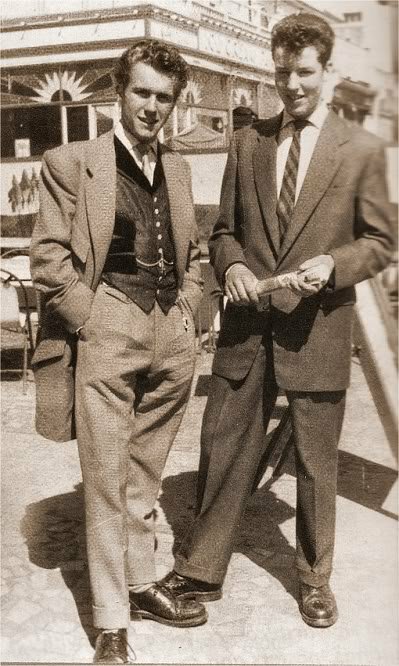
Teddy Boys pictured at Worthing, Sussex in 1955.
For those who are unaware, the Edwardian image and lifestyle is very much alive and kicking today as it was during the 1950's and then in the 1970's. The outfit is practically unchanged, the haircuts, and the music are still the same.
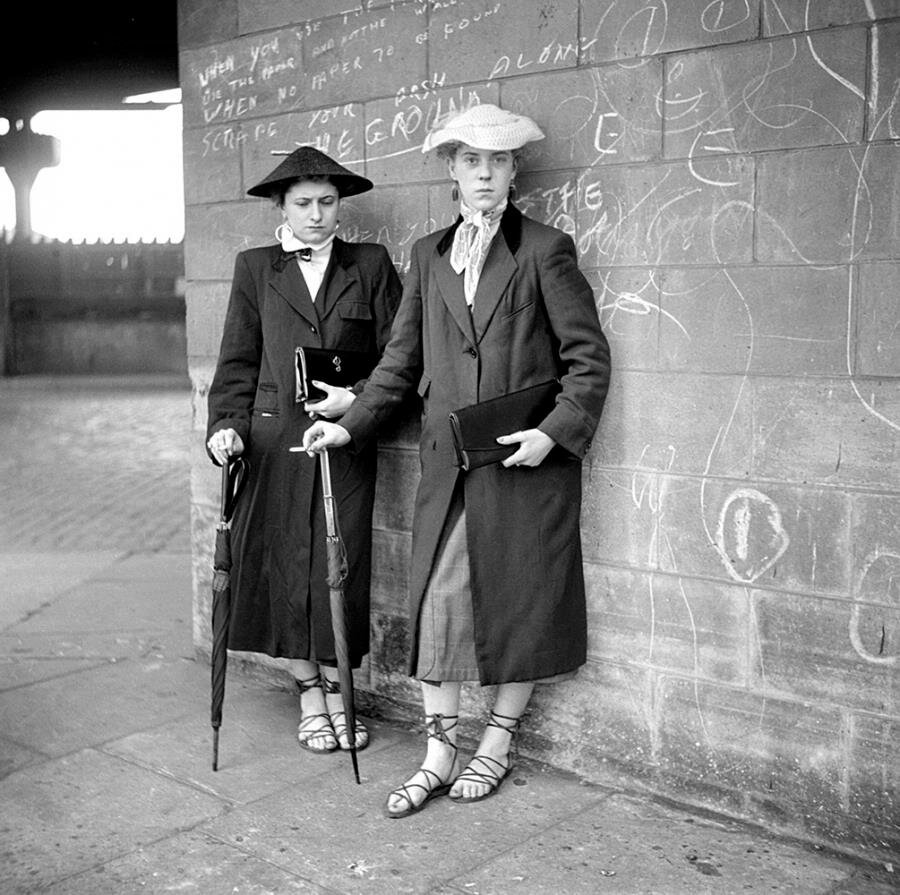
Photograph by Ken Russell January 1955 of Teddy Girls, Pat Wiles and Iris Thornton, aged 17 from Plaistow, showing off their lace up espadrilles.
At Rock 'n' Roll clubs throughout Britain, Teddy Boys and Girls still strut their stuff on the dance floors, bopping and jiving to their favorite music.
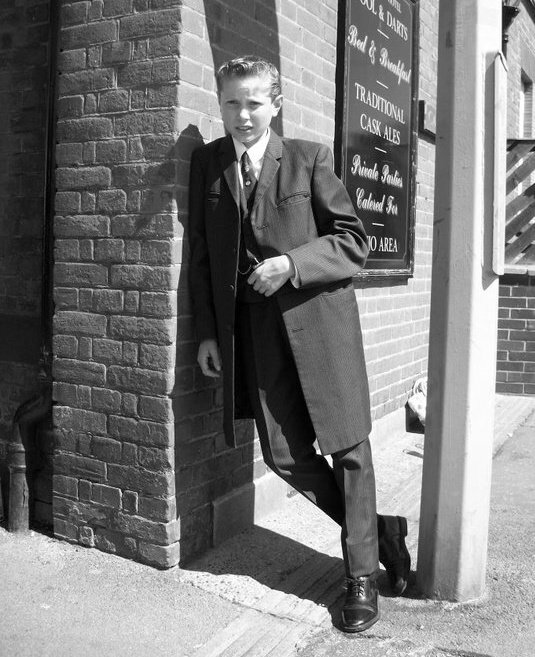
A young Teddy Boy in 2012 from Stockton-on-Tees keeping the movement alive.
The only difference is that the aggressiveness of their predecessors has all but gone, the fighting in the cinemas, and the weapons are but a thing of the past. However, one thing is for sure, the great British Teddy Boy is here to stay.
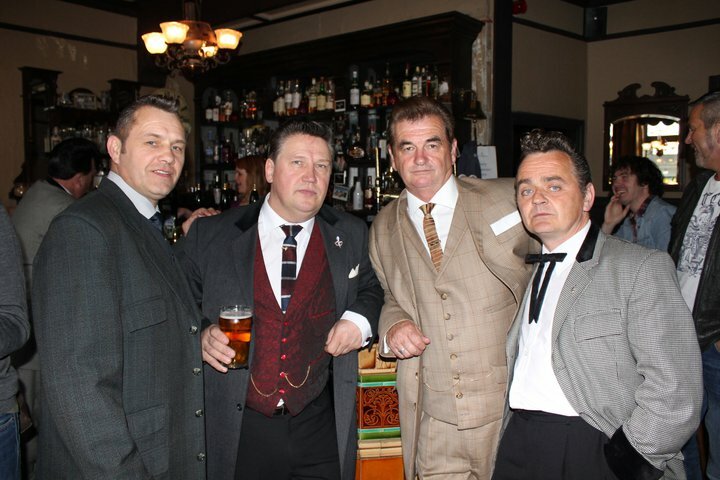
Members of the Manchester Peacock Society pose at the Castle Pub in Oldham Street, Manchester', 30th May 2011.
This site is designed to educate and inform all who are genuinely interested the history of the Teddy Boy as a British cultural icon and those who are studying fashion and popular culture including the development of British Rock 'n' Roll music. I hope that you will find this developing site a useful source of historic and current information.
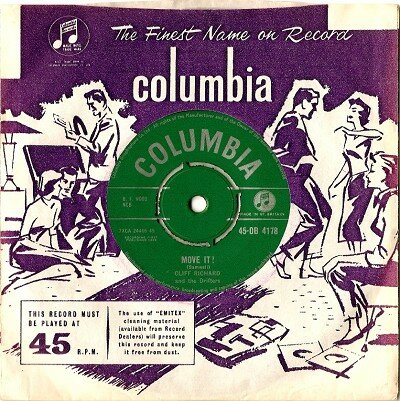
Regards
John aka Rockin' Nidge
_________________________________
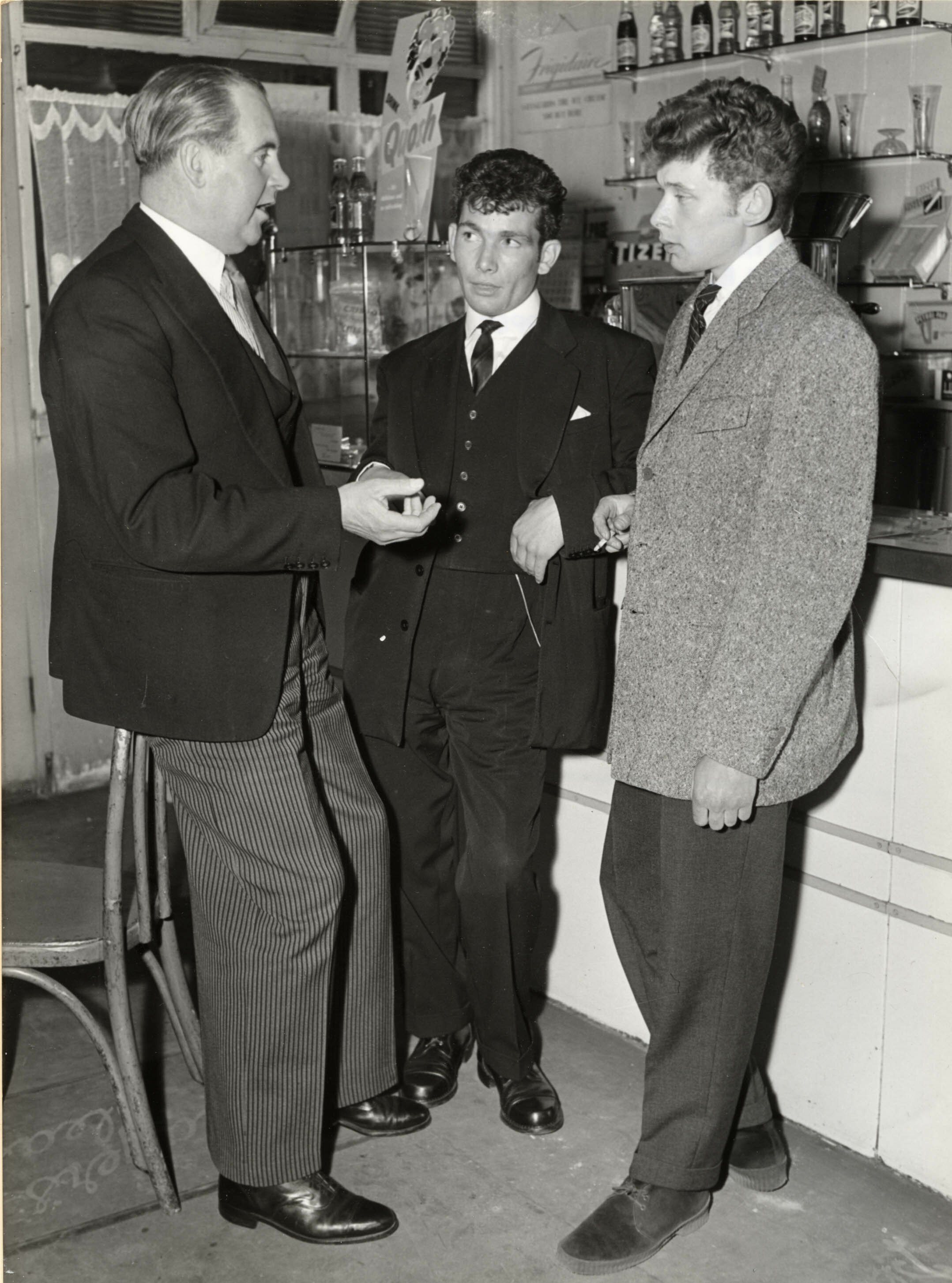
Norman Noel Dodds (1903-1965), Labour Cooperative politician pictured talking to two typical "Teddy Boys" with their Edwardian style clothes and "Tony Curtis" hairstyles in a Cafe in July 1955. Norman Dodds was the MP for Dartford from 1945-1955 and for Erith and Crayford from 1955 to 1965 until his death at the age of 61.
_______________________________________________________________________
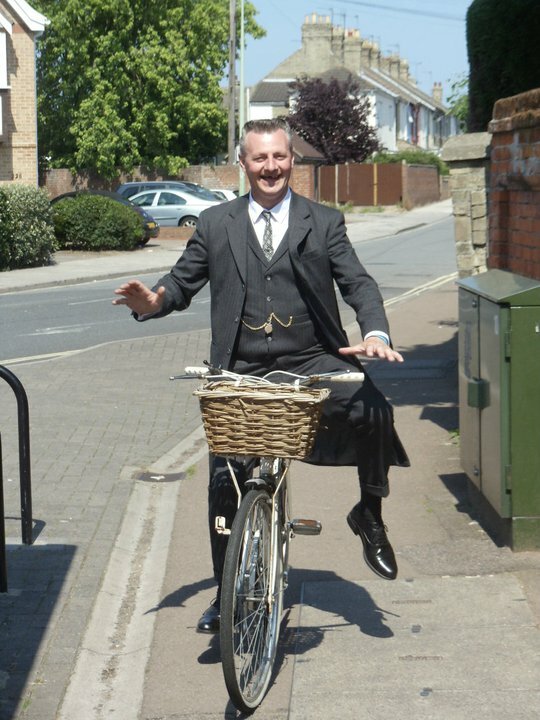
Edwardian Teddy Boy Mick Mcloughlin cycles in to The Tramway Hotel, Pakefield, Lowestoft in July 2011.
_________________________________
Teddy Boys on T.V.
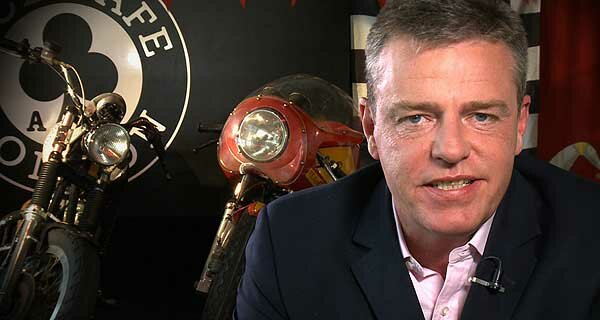
Simply Media TV produced a Television Documentary called Teen Spirit: 'Here Come the Teds' which was filmed at the 'Wildest Cats in Town' Weekender in June / July 2011. This was narrated by Graham McPherson (better known as ex-Madness singer 'Suggs') and was originally broadcast on Thursday 26th January 2012 at 9.00 pm on the Yesterday Channel. It has been subsequently repeated, however if you missed it, you can view the documentary on the Here comes the Teds page.

______________________________________________________________________
Book on the History of the Teddy Boy Movement - written by two top Teddy Boys.
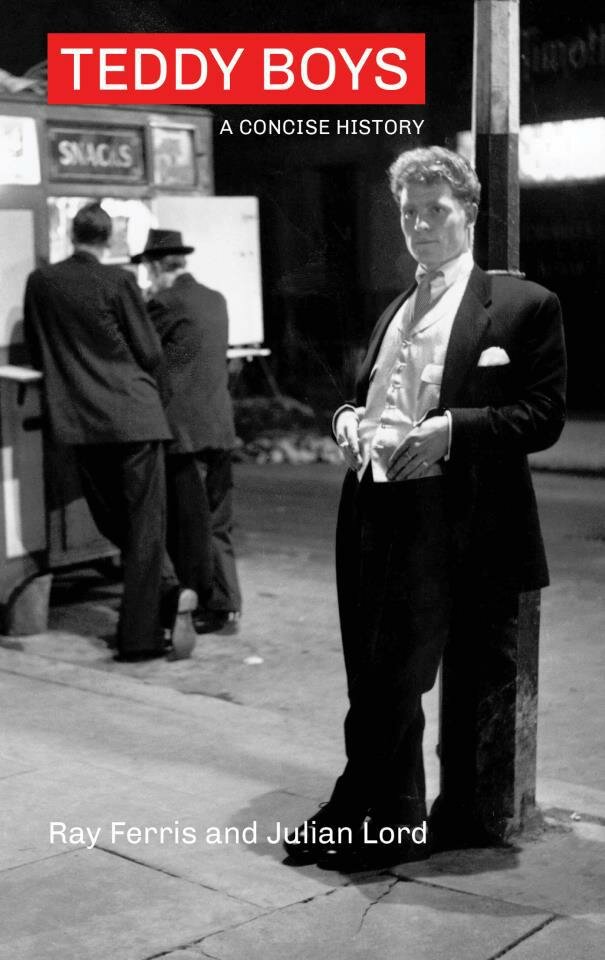
No youth cult has been so enduring, yet so misunderstood, as the Teddy Boys. They were maligned by a British Establishment that had no clue what they were about, and as the movement grew that scorn turned to fear. Teddy Boys tells of their roots, the music of jive and boogie artists, how the fashion became associated with violence and how the Teds fell into decline after the 1958 Notting Hill Riots. Their spirit was preserved by the Rockers of the 60s and through the rising popularity of rockabilly across Europe and beyond.
'Teddy Boys - a concise History' is a great book that was released on 1st December 2012 and written by Ray Ferris and Julian Lord based on an idea from Paul Ramsbottom. Retail Price approx: £8.00. The Ted on the finalised front cover is London Gang member, Colin Donellan taken on 10th October 1953.
______________________________________________________________________

This book, which came out in November 2015 was put together by Michael McIlwee who is the Information Officer at Liverpool John Moores University. The actual information in the book was gathered and collected over a number of years by Teddy Boy Brian Rushgrove. Michael McIlwee has written a number of books on the history of gangs in and around Liverpool.
In the mid-1950s, British society was gripped by a sudden terror: of its own youth. The murder of a 17-year-old Londoner in September 1953 marked the start of a strange and horrifying fad. As if from nowhere, gangs of young men, dressed in a remarkable new fashion, emerged to turn the streets, dance halls and fairgrounds into battlefields. The Teddy Boys had arrived.
Soon they were blamed for a rising tide of post-War crime. Successors to aggressive thugs known as Cosh Boys, the Teds combined English Edwardian dress with American zoot-suit style, with weapons an essential accessory. Accounts of their sorties with knives, chains and knuckledusters filled the newspapers, and from the seminal Battle of St Mary Cray, in 1954, to mass brawls in Birmingham, Glasgow, Liverpool and Manchester, few towns or cities were unaffected. Some of the worst affrays pitched them against National Service squaddies and American GIs based in the UK. Various fighters claimed the title King of the Teds, some of them hyped by the. Teddy Girls joined in enthusiastically. Then the arrival of rock 'n' roll and the movie Rock Around the Clock sparked a wave of cinema riots, further condemnation and a sharp police and judicial response.
Yet others saw the Teds as a positive sign of an independent generation unbound by the restrictive attitudes of their parents, and similar fashions were embraced by teenagers abroad, from the Blousons Noir of France to the Bodgies of Australia. The Ted movement inevitably declined as the originals grew up, got married and had children. But their legacy survives to this day. Well done Brian Rushgrove for what is actually a collection of your material!
Available from Amazon.
______________________________________________________________________
The Edwardian Teddy Boy and the Teddy Boy Movement.
_________________________________
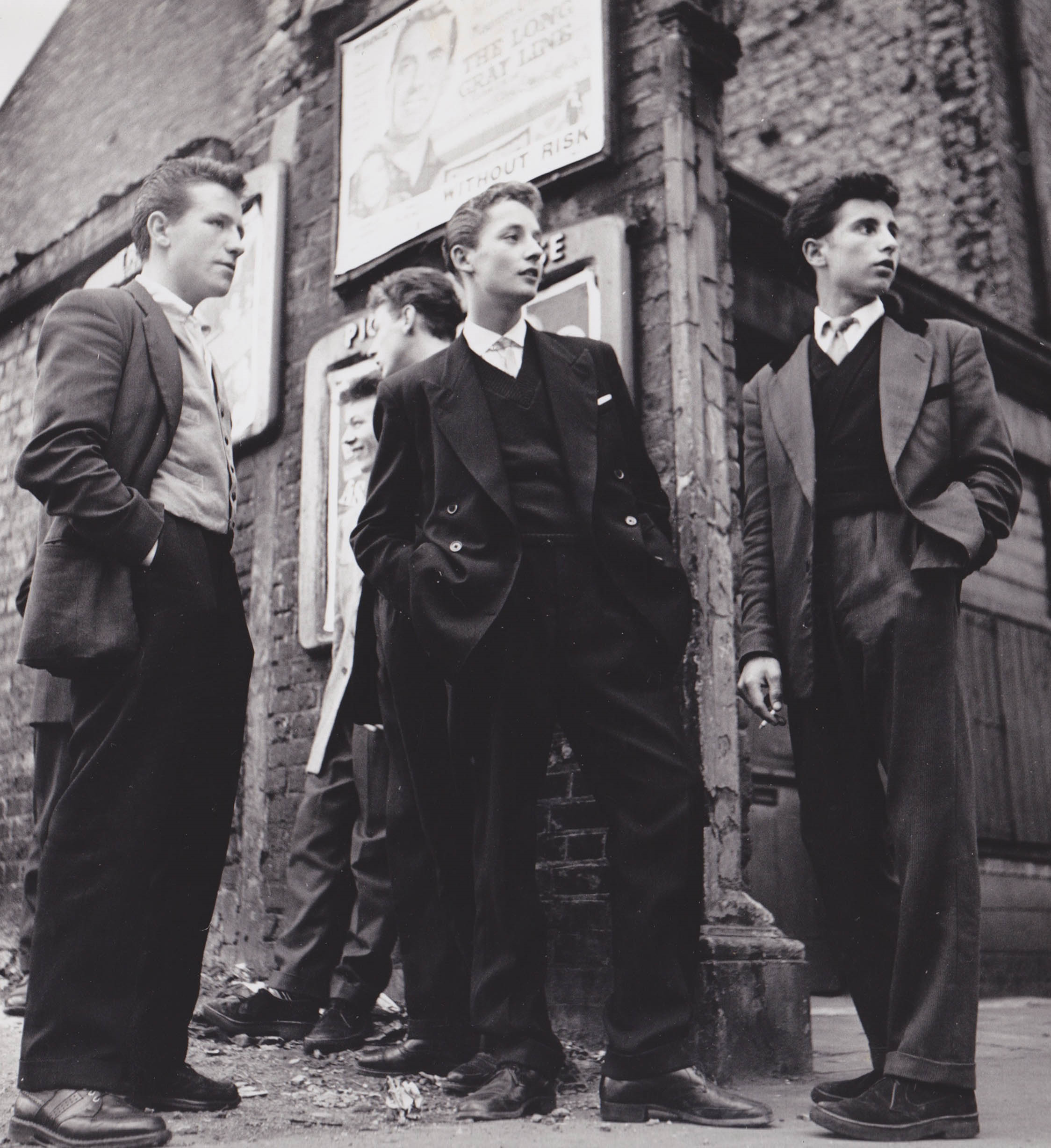
Teddy Boys gather outside a Picture House on the Old Kent Road 1955.
In March of 1954, a sixteen year-old youth had been convicted at Dartford Magistrate's Court of robbing a woman 'by putting her in fear'. The Chairman of the Magistrates said:
"There are a lot of things and so-called pleasures of the world which demand a lot of money. You tried to get hold of money for ridiculous things like Edwardian suits. They are ridiculous in the eyes of ordinary people. They are flashy, cheap and nasty, and stamp the wearer as a particular undesirable type."
"In April two gangs, also dressed Edwardian-style, met after a dance, at St Mary Cray, Kent, Railway Station. They were ready for action: bricks and sand-filled socks were used. Fifty-five youths were taken in for questioning."
"East of Barking in the summer of 1954, on a train from Southend, someone pulled the communication cord. The train ground to a halt. Light bulbs were smashed. When the train eventually reached Barking, Police arrested a gang dressed in Edwardian suits"
"The Teddy Boy myth was born.''
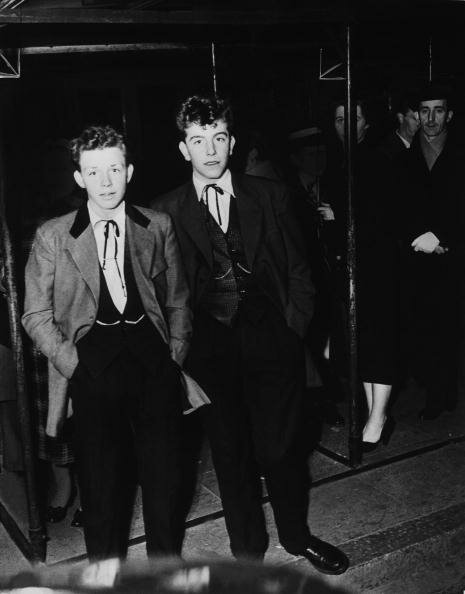
Two original 1954 Teddy Boys at Kingston upon Thames wearing Drape Jackets with 4" wide lapels, silk patterned waistcoats and trousers with pleated fronts and 16" bottoms with turn-ups.
"Cinemas, Dance halls and other places of entertainment in South-East London are closing their doors to youths in 'Edwardian' suits because of gang hooliganism. The ban, which week by week is becoming more generally applied, is believed by Police to be one of the main reasons for the extension of the area in which fights with knuckle dusters, coshes, and similar weapons between bands of teenagers can now be anticipated. In Cinemas, seats have been slashed with razors and had dozens of meat skewers stuck into them." - Daily Mail, 12th April 1954.
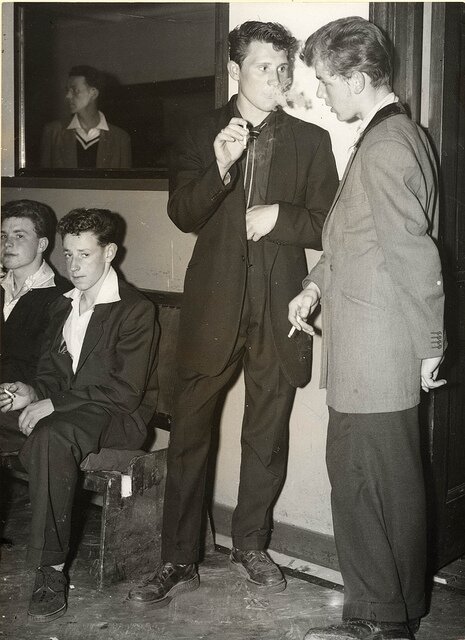
The Stag-Line at a Dance Hall. The Teddy Boy in the centre is wearing an Edwardian outfit, which may have cost him as much as £50.00 ( very expensive at the time). Note the Long Jacket with 'Shawl' collar and single link button fastening (nearly coming off), Drainpipe trousers, thick Crepe soled shoes ('Creepers') and parallel-striped 'Slim Jim' tie. The boy on the right has a 'Tony Curtis' haircut and is wearing crepe soled suede shoes. - July 1955.
Welcome to The Edwardian Teddy Boy, a proactive website that is dedicated to maintaining and furthering the British Teddy Boy movement and culture amongst like-minded people throughout Britain and Ireland and the rest of the World.
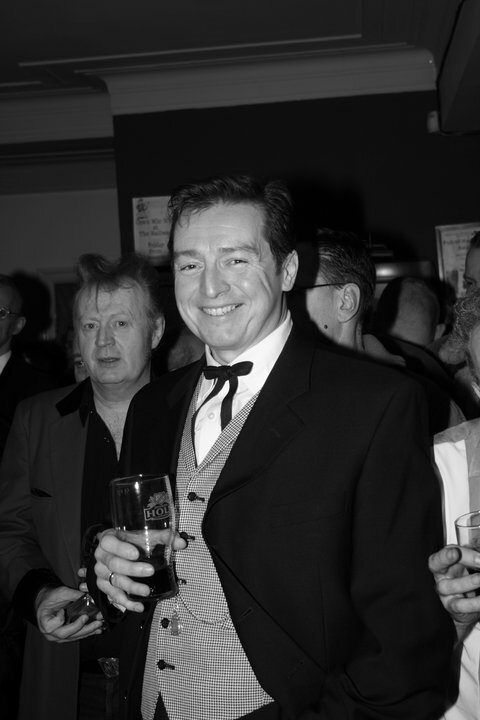
Totally authentic Edwardian Teddy Boy, Paul Trainor from Eccles, Lancashire.
This is a site where Teddy Boys & Girls who are committed to the 1950's neo-Edwardian lifestyle can access current and historical information, news, details of events and view photographs from Teddy Boy and Rock 'n' Roll events.
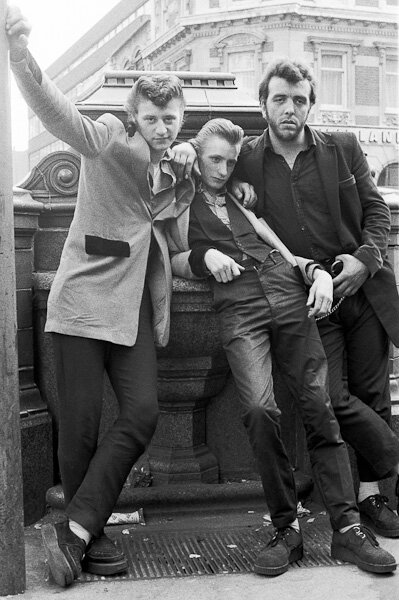
Teddy Boys pictured at Surrey Street Market, Croydon, Surrey in 1976. Left to Right: Unknown, Micky Mould & Brian Boyce. Photograph: Chris Steele-Perkins.
'The Edwardian Teddy Boy' as a website, was started in April 2010 and has been built by Edwardian Teddy Boy, John aka Rockin Nidge.
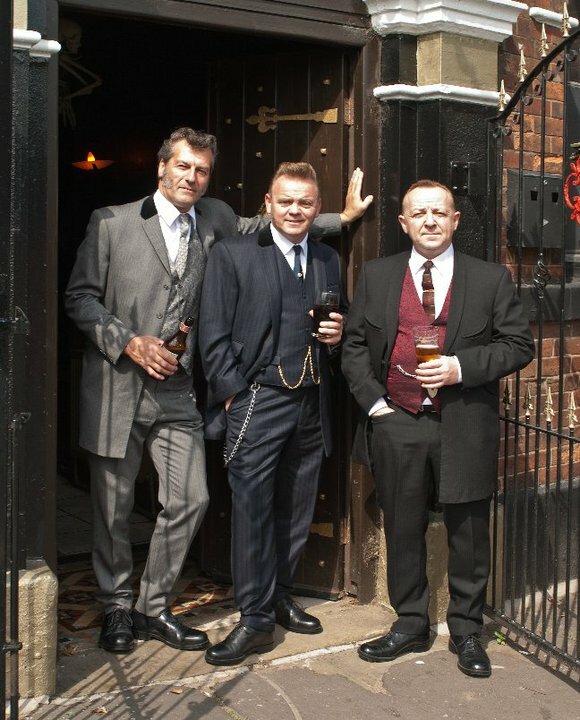
Edwardian Teddy Boys - Jake and Gaz from Preston & John from Oldham, Lancashire.
This is a very useful website for those who are researching 1950's British Youth culture, British Rock 'n' Roll and the evolution of the Teddy Boys. From their conception in the early fifties through the so called Rock 'n' Roll Revival of the late 1960's and 1970's through to the return to the fifties neo-Edwardian roots and the evolvement of The Edwardian Drape Society during the mid 1990's, and to the present day, the Teddy Boy has always been an icon of British Youth Culture and Lifestyle.
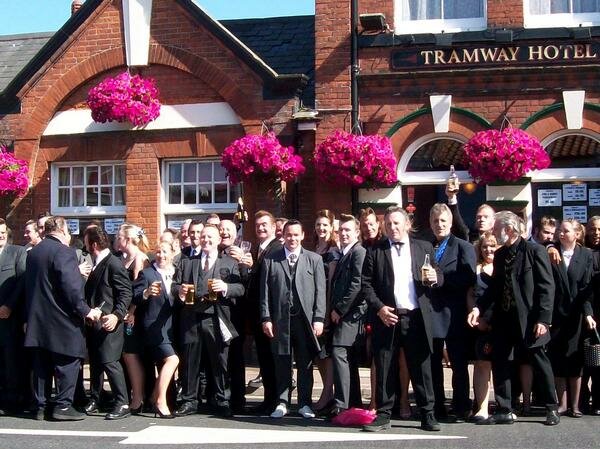
The 'Tramways' at Pakefield, Lowestoft hosts the Edwardian Invasion each year and has now become an annual Saturday afternoon pilgrimage for Teddy Boys & Girls whilst attending the 'Wildest Cats in Town' weekender in early July.
The Edwardian Teddy Boy website is specifically for Teddy Boys and Teddy Girls who are dedicated to perpetuating and maintaining the authentic 1950's Teddy Boy image and lifestyle. However always remember that Teddy Boy attire is a style and not a uniform and the whole reason for wearing the gear is that it enables the individual to make their own design within a given style.
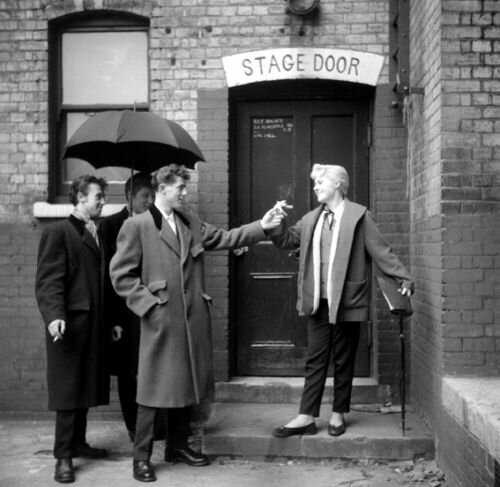
A famous photograph taken by photographer, Ken Russell in January 1955 by at the back of the Walthamstow Palace Theatre of a small group of Teddy boys talking to 17 year old Josie Buchan a Teddy Girl who is sporting a DA hairstyle which was unusual for women in 1955.
British Rock 'n' Roll
The Edwardian Teddy Boy strongly supports British Rock n Roll music from original artists such as Tommy Steele, Tony Crombie & his Rockets, Terry Dene, Billy Fury and Cliff Richard & the Drifters.
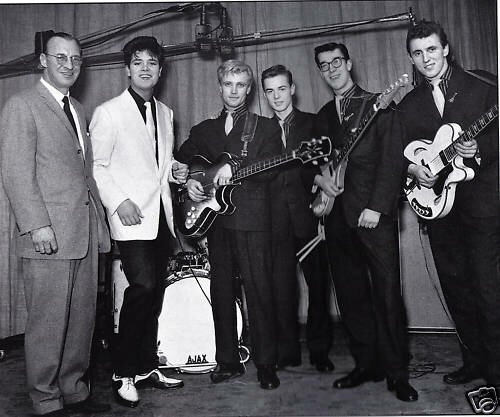
Norrie Paramor with Cliff Richard & the Drifters - Jet Harris, Tony Meehan, Hank Marvin & Bruce Welch in 1958.
The site also promotes ALL forms of 1950's Rock 'n' Roll music such as Doo Wop, Rockabilly, main stream Rock 'n' Roll and British Rock n Roll.
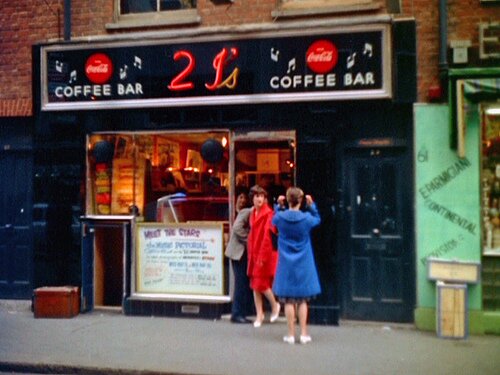
The 2i's Coffee Bar, Old Compton Street, Soho, in London's West End in 1959 - Birthplace of British Rock 'n' Roll. The 2i's Coffee Bar was a coffee bar upstairs and in the basement was a small area where emerging British Rock 'n' Roll artists and groups were able to perform. It was situated at 59 Old Compton Street, Soho, London, England, between 1956 and 1970. The 2i's was owned by Paul Lincoln, an Australian wrestler and wrestling promoter.
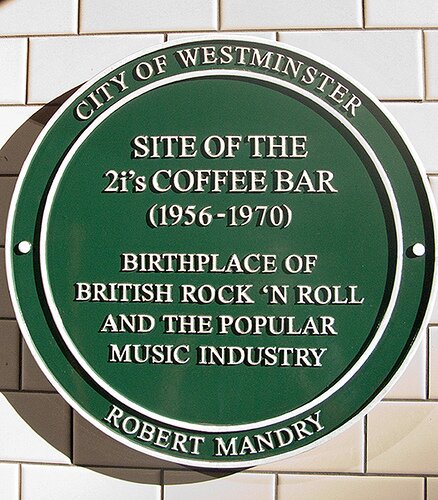
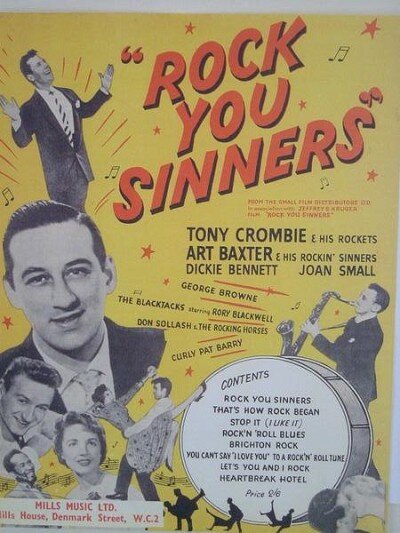
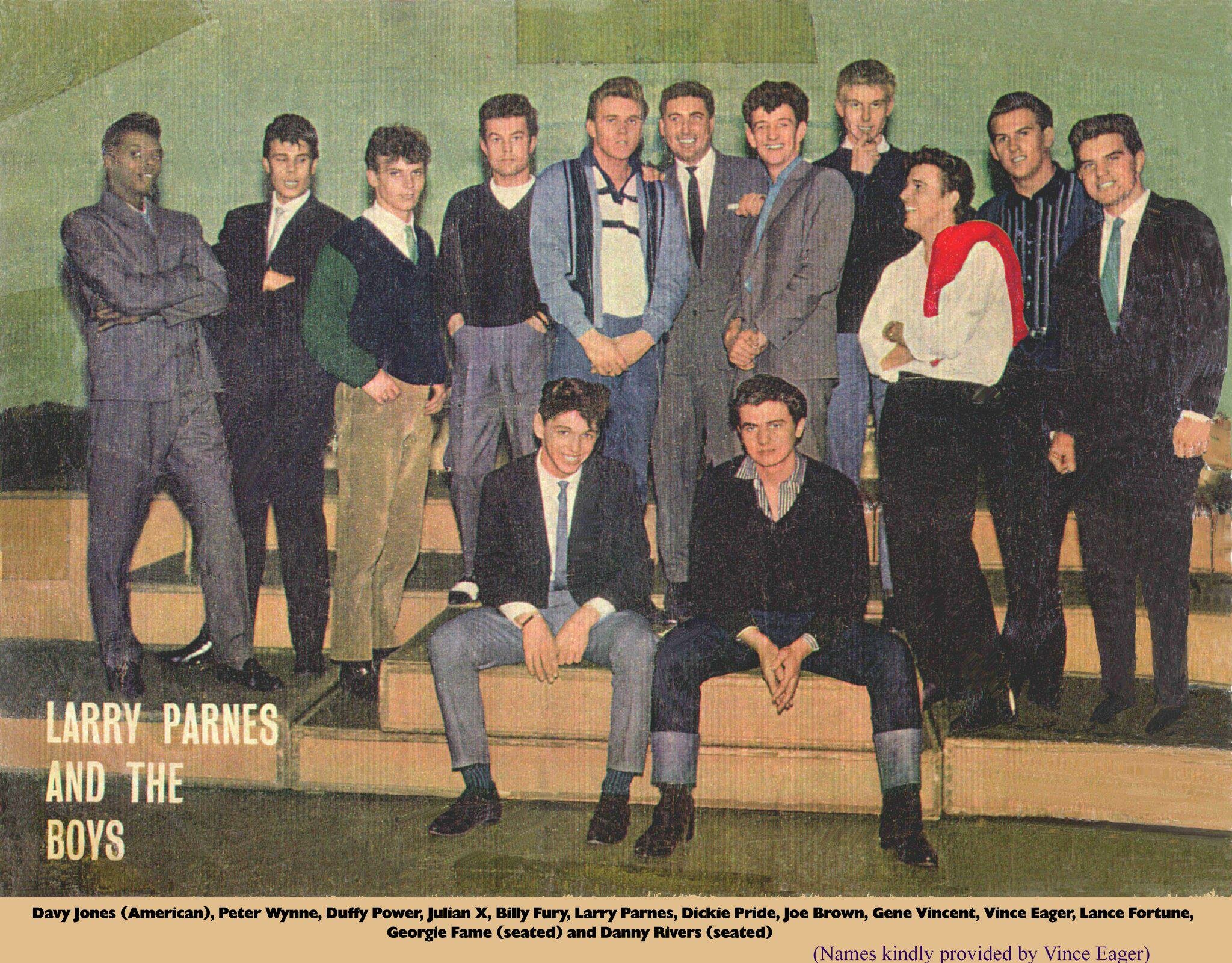
The Edwardian Teddy Boy website acts as a link and source of information for all drape wearing Teddy Boys and Girls and promotes the common cause of maintaining the British Teddy Boy culture and lifestyle.
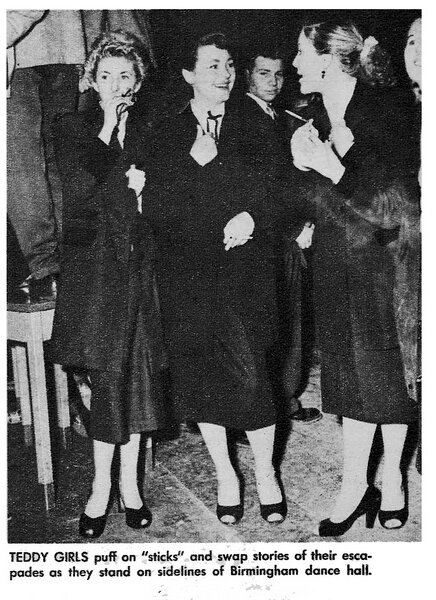
The Edwardian Teddy Boy has always been in support of the original pre 1955 Teddy Boy style of dress. However, the actual return to the original Conservative Edwardian style of Teddy Boy dress was originally a concept that was steadily being developed during the mid to late 1980's.
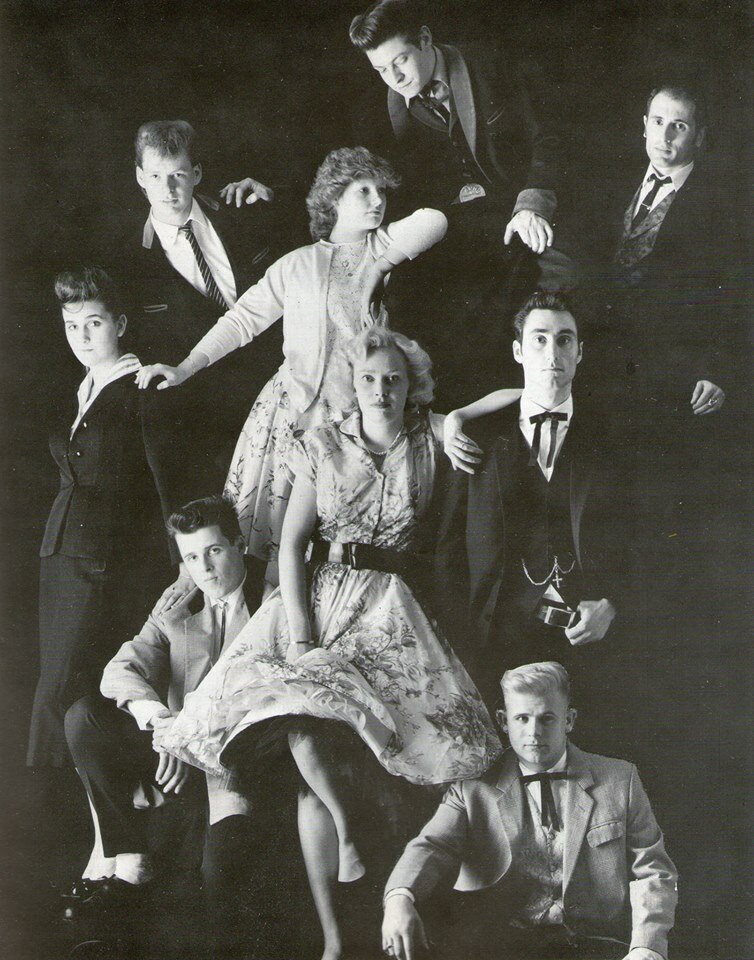
Regular members of the London Rock n Roll Club photographed at The Edwardian Club, Southgate, North London in 1986 featured in the HMV booklet 'British Youth Culture'.
Teddy Boys at venues such as the Edwardian Club in Southgate, North London and Paul Culshaw and his Farnborough Edwardians were examples of this. This was because many Teddy Boys had become disgruntled with the 1970's glam image that had dominated the Teddy Boy style during the 1970's.
Later in 1992, The Edwardian Drape Society (T.E.D.S.) was started in a move to support and promote of the re-claiming of the original 1950's Teddy Boy style back into Teddy Boy culture.
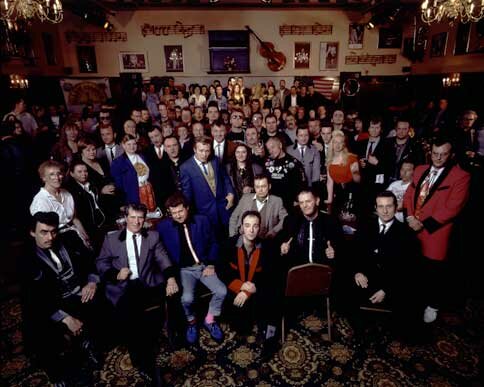
Teddy Boys and Girls at the Tennessee Club in the mid 1990's
As a well known Teddy Boy from North London says: "It's great what The Edwardian Drape Society set out to do back then in those days, because this had a permanent and lasting effect on putting our image right."
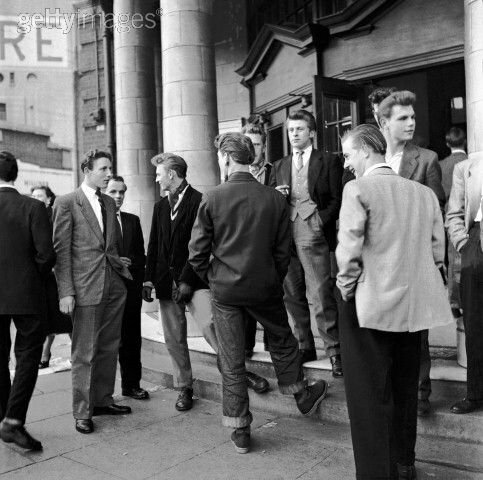
Manchester Teddy Boys outside a Cinema in 1955.
There are now a large number of Teddy Boys who are very much in support of the ethic of maintaining and promoting the original pre 1955 Conservative Edwardian Teddy Boy style and this site actively encourages this. Typically this involves the wearing of Drape jackets with 3"- 4" lapels, minimum use of velvet apart from the collars and cuffs (or none at all), matching or silk patterned brocade waistcoats and 16" bottom trousers with turn-ups.
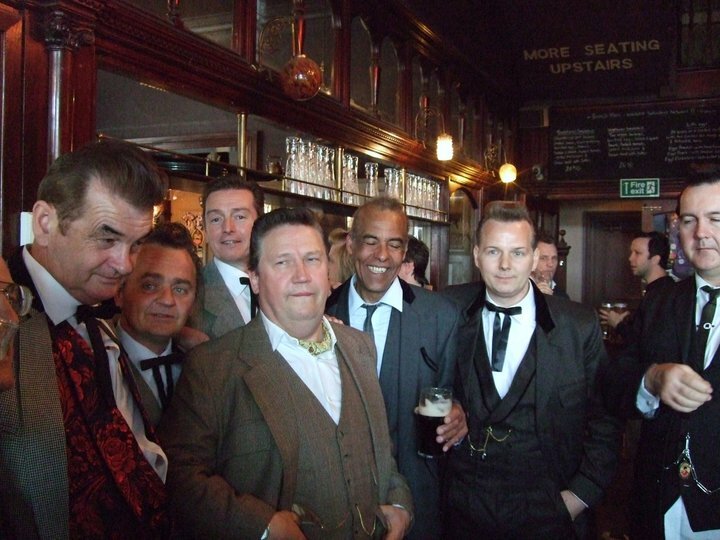
Edwardian Teddy Boys at the Adelphi Pub in Leeds on 30 April 2011 taking part in the Ted's Around Town in Leeds Pub Crawl.
When Teddy Boys first emerged in 1953 amongst British working class youths, it became acceptable for young people to care about what they looked like and to dress for show, instead of having work or school clothes and Sunday-best.
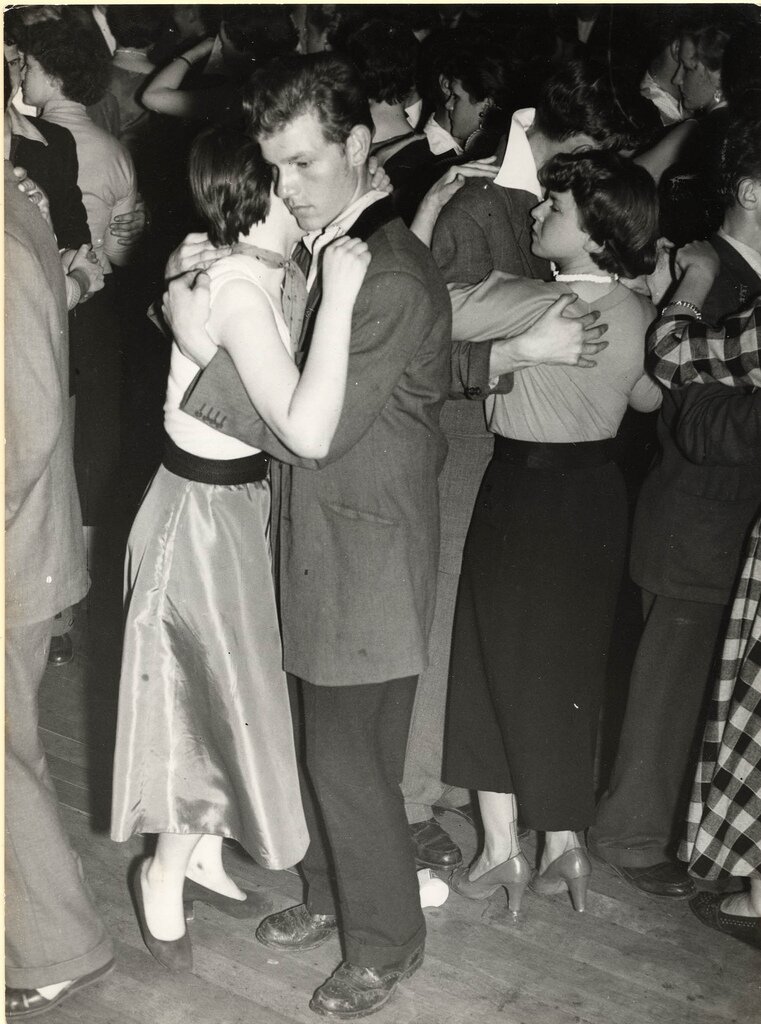
A Teddy Boy with his girl 'Moon Dance' at a Dance Hall - July 1955 - note the Drape Jacket with half back full velvet collar with 16-17" turned up trousers and Brogue Shoes.
Today people dress very casually and there seems not to be the same sense of occasion when Going out on the Town. This was never the case for the Teddy Boys, who despite their reputation always dressed up and strutted around like peacocks when they went out.
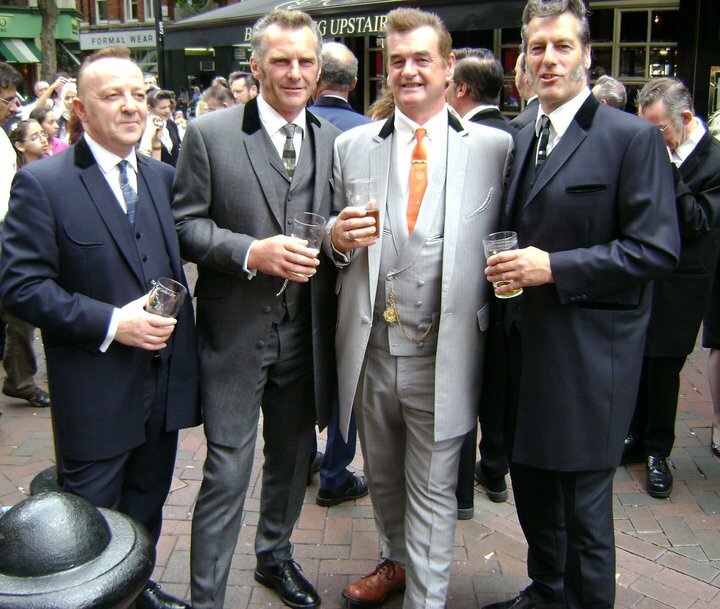
The Edwardian Teddy Boy website encourages those like-minded individuals who are committed to emulating the original Teddy Boy styles as near as possible, taking into account regional variations.
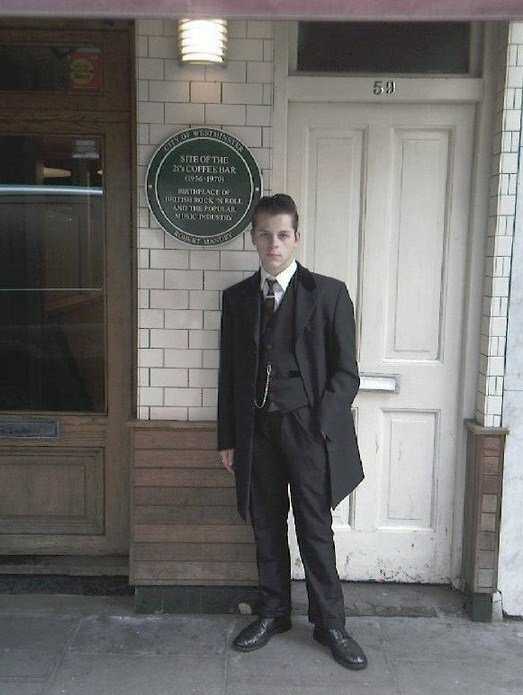
The Edwardian Teddy Boy is keen to stimulate interest amongst younger people and develop them to become the Teddy Boys of the future and continue to keep the neo-Edwardian culture alive.
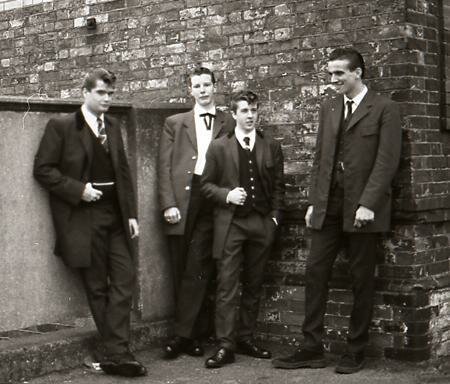
Edwardian Teddy Boys in the 1980's recreating the original pre 1955 style L to R: Paul Culshaw, Richard Wooley, Jerry Lunn & Frankie Calland.
The Edwardian Teddy Boy website is certainly not telling anyone what to wear and is in no position to do so. However, this site is somewhat cognosenti about authentic Teddy Boy attire and is keen to emulate and encourage the wearing of the original 1950's Teddy Boy styles in terms of colours, suiting's, footwear and clothing accessories as much as possible.
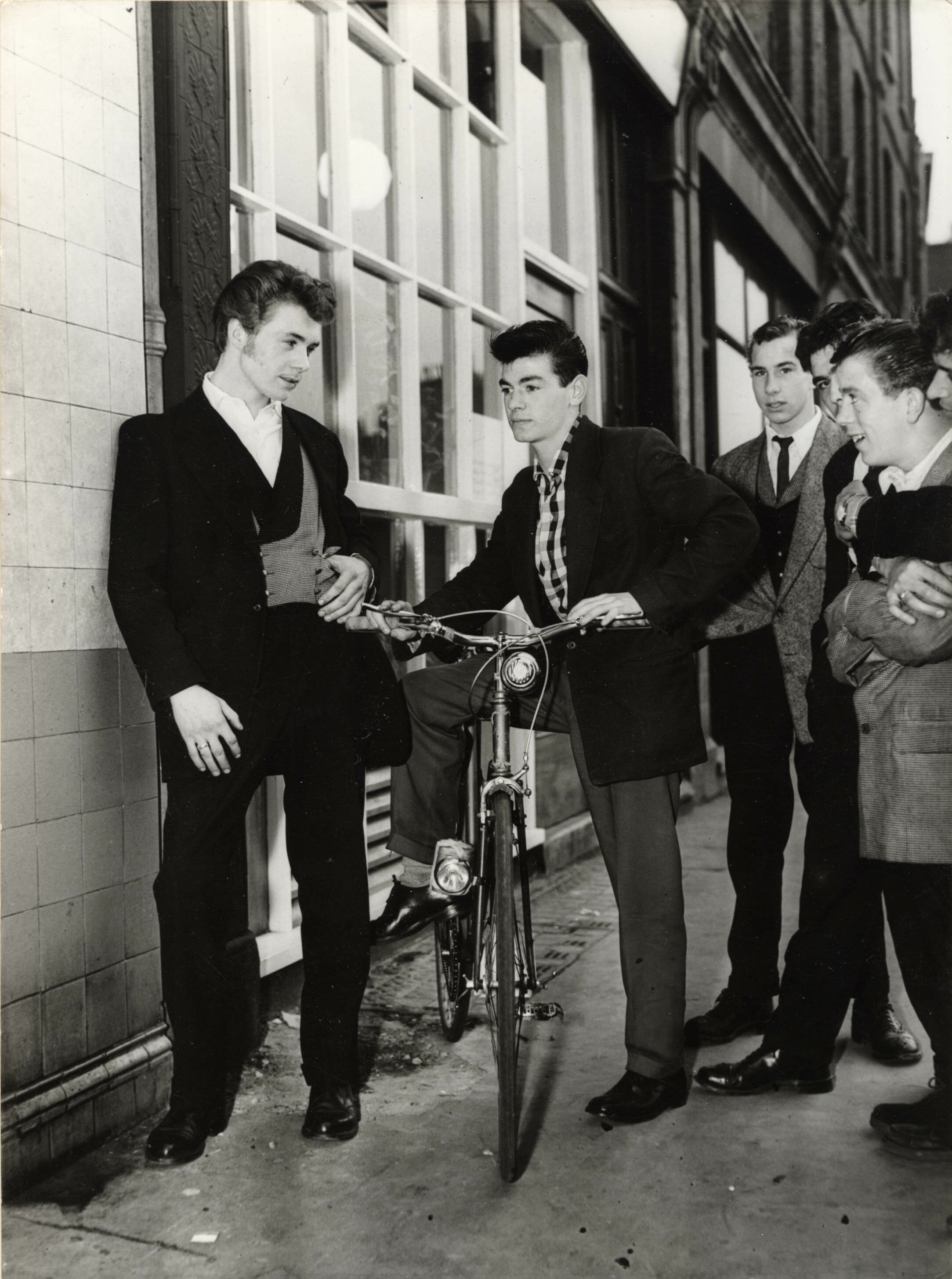
Boys wearing Edwardian style clothes at the "Teen Canteen" at Elephant & Castle, South London, July 1955 - note the unusually long sideburns of the Teddy Boy with the double breasted waistcoat for the period..
The Edwardian Teddy Boy is particularly against the 'Glam Rock' influence that was responsible for bastardising much of the Teddy Boy attire worn during the 1970's and support a return to the more authentic 1950's style.
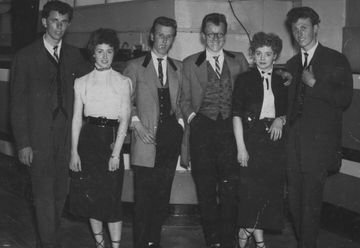
A Group of Deeside Teddy Boys and Girls at the Tower Ballroom, New Brighton, Cheshire in the Mid 1950s
The Edwardian Teddy Boy website embraces and welcomes all committed Teddy Boys and Girls. We encourage those of you to dress smartly and wear your clothes with pride when attending Teddy Boy and Rock 'n' Roll events, venues and functions.
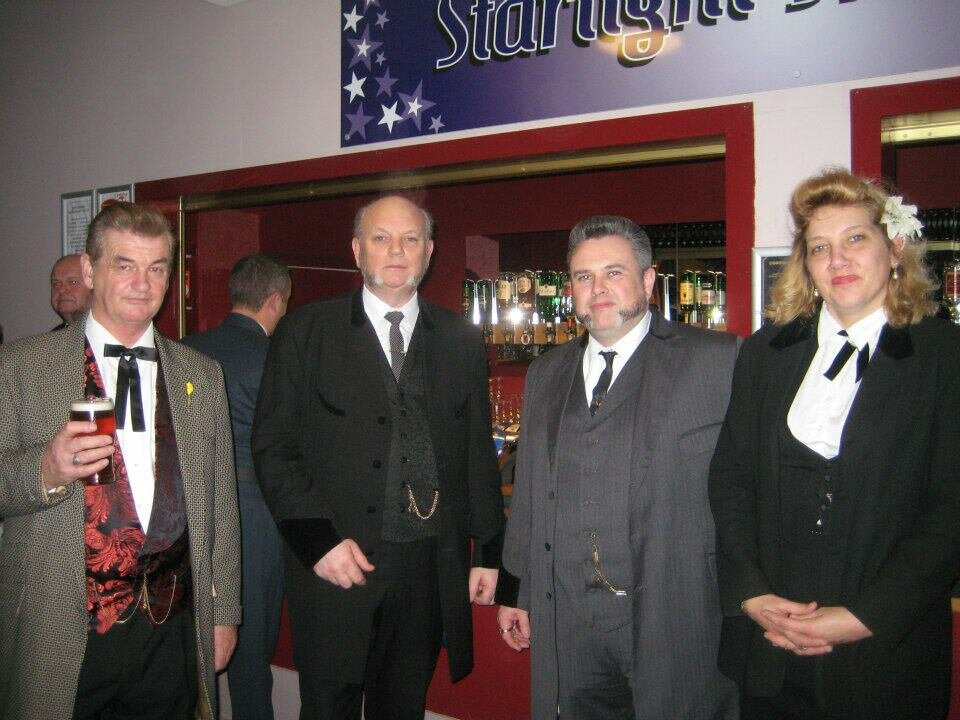
At Steph and Michele Brian's Wedding at Mundersley - Nidge, Roger, Jonny and Sophie in true Edwardain style, March 2012.
There is too much emphasis on dressing casually these days and this seems to have become the norm. We, as proud Edwardian Teddy Boys and Girls on the other hand want to dress and stand out and apart from the rest!
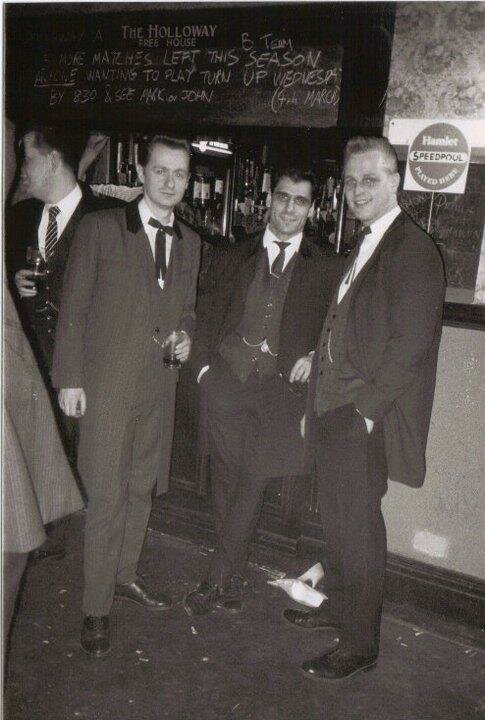
Well dressed Edwardian's Steve, Pete and Mark at a TEDS Do at the Holloway Tavern 1992.
In the last 30 years Teddy Boys in Britain have fostered and strengthened links with Teddy Boy groups that have emerged and developed in Europe, particularly in Germany, France, Spain, Norway and Finland.
These links have strengthened the Edwardian brotherhood considerably and there are regular events that British Teddy Boys attend in these countries. Our European counterparts are regular supporters of functions and events held here in the UK .
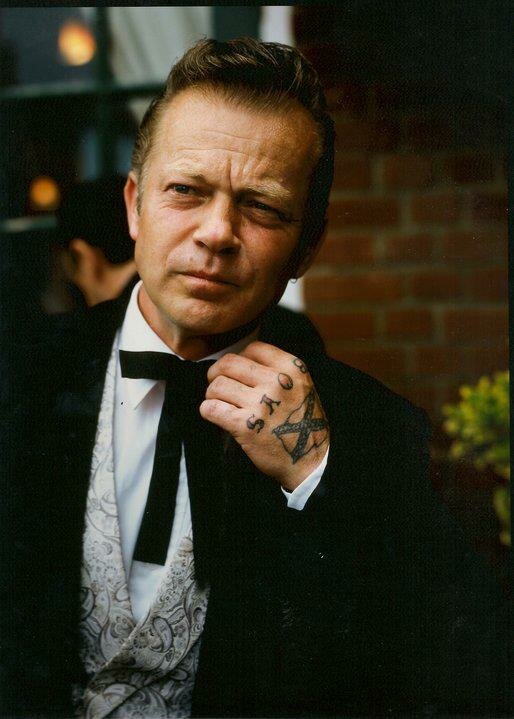
Well known London Teddy Boy, Johnny T.
1979 TV Documentary 'England Their England' featuring workers from Raleigh Cycle Factory Nottingham. It features Clive Hodgson, Teddy Boy and Rock' n' Roll DJ, playing at the 'Cocked Hat' pub. Featuring Tony Goodman and all.
Please note that this website is maintained by Rockin' Nidge and that the views and comments expressed therein, are not necessarily those shared by the rank and file of Teddy Boy's.
If you wish to contact Nidge regarding any comments or statements on this website, please feel free to email Nidge at: shanganipatrol@ntlworld.com .
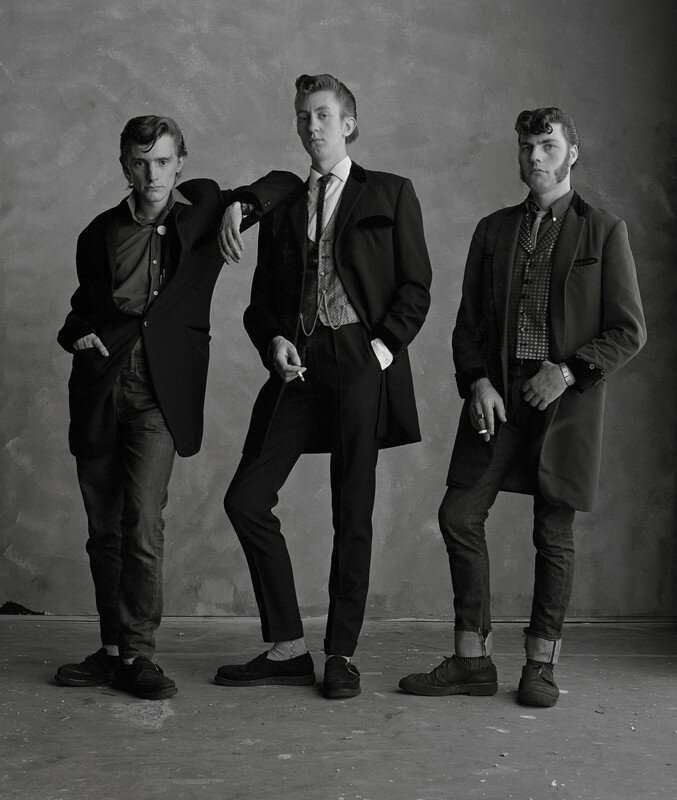
An iconic photograph taken in 1970 with Ray Flight (centre), then 22 years of age with 'Driftin' Den Board (right) and Dick (surname unknown) on the left. Ray is wearing a midnight blue drape suit with black velvet, gold waistcoat and black suede buckle creepers. Although these Teds are pictured during the late 1960's / 1970's period, they have resisted the glam rock image that many Teds adopted during the seventies.

